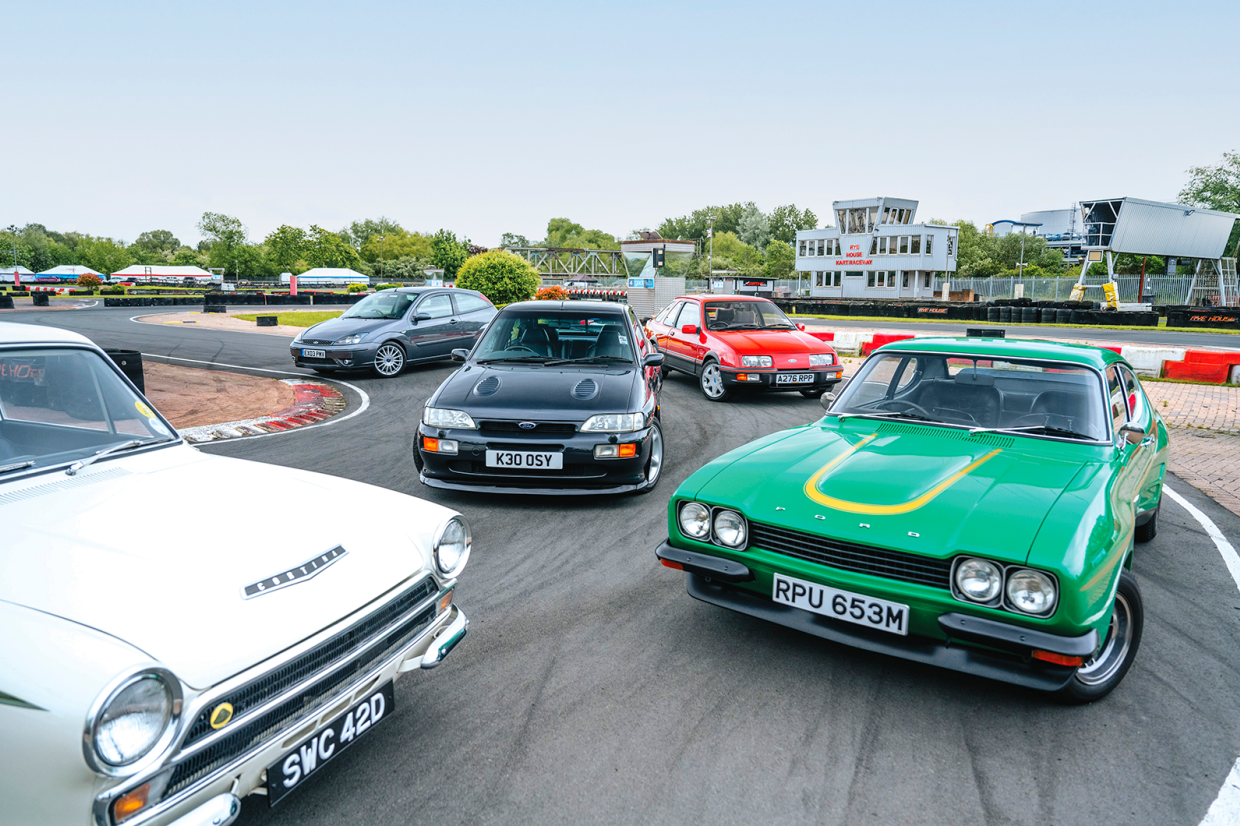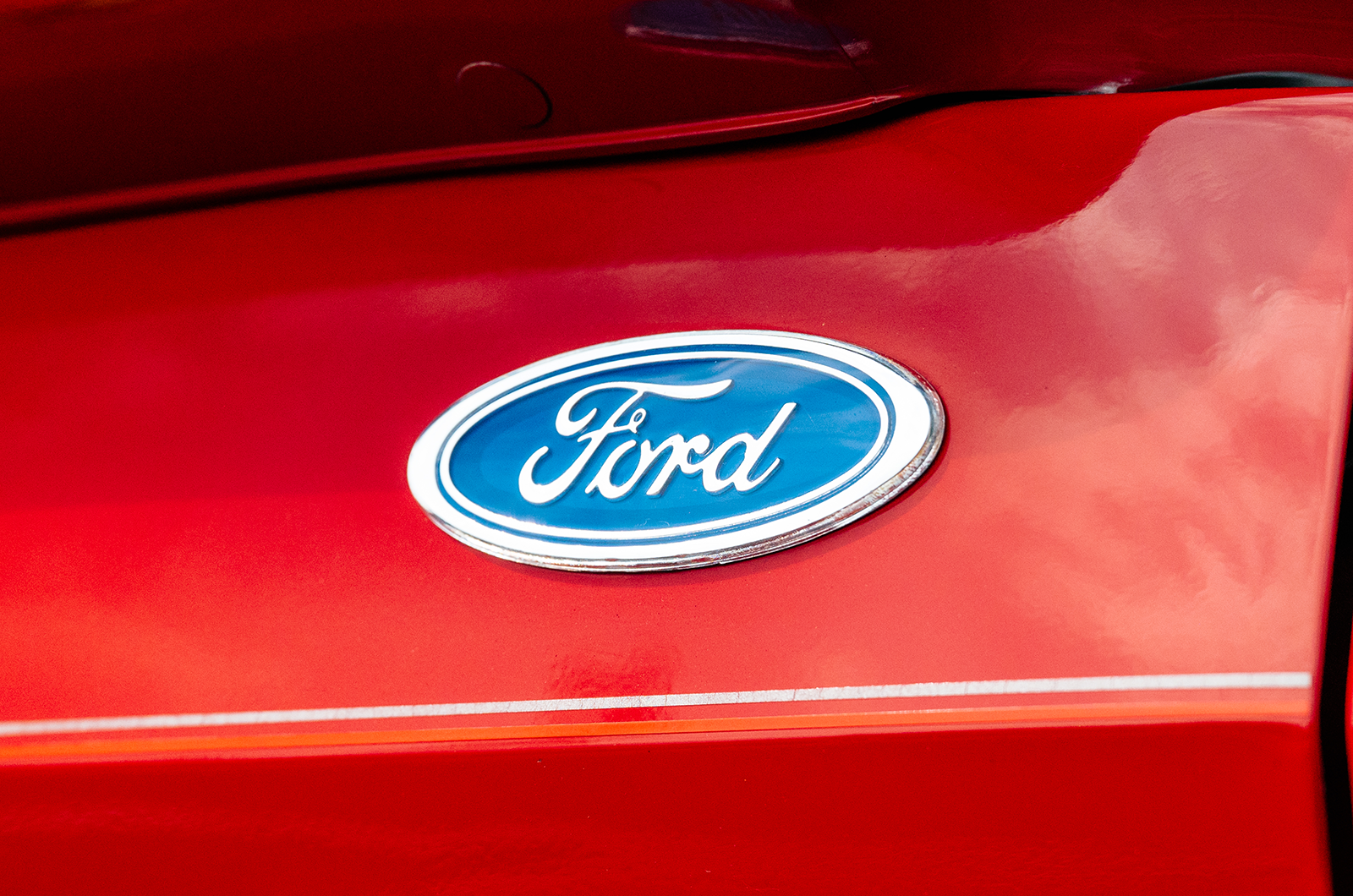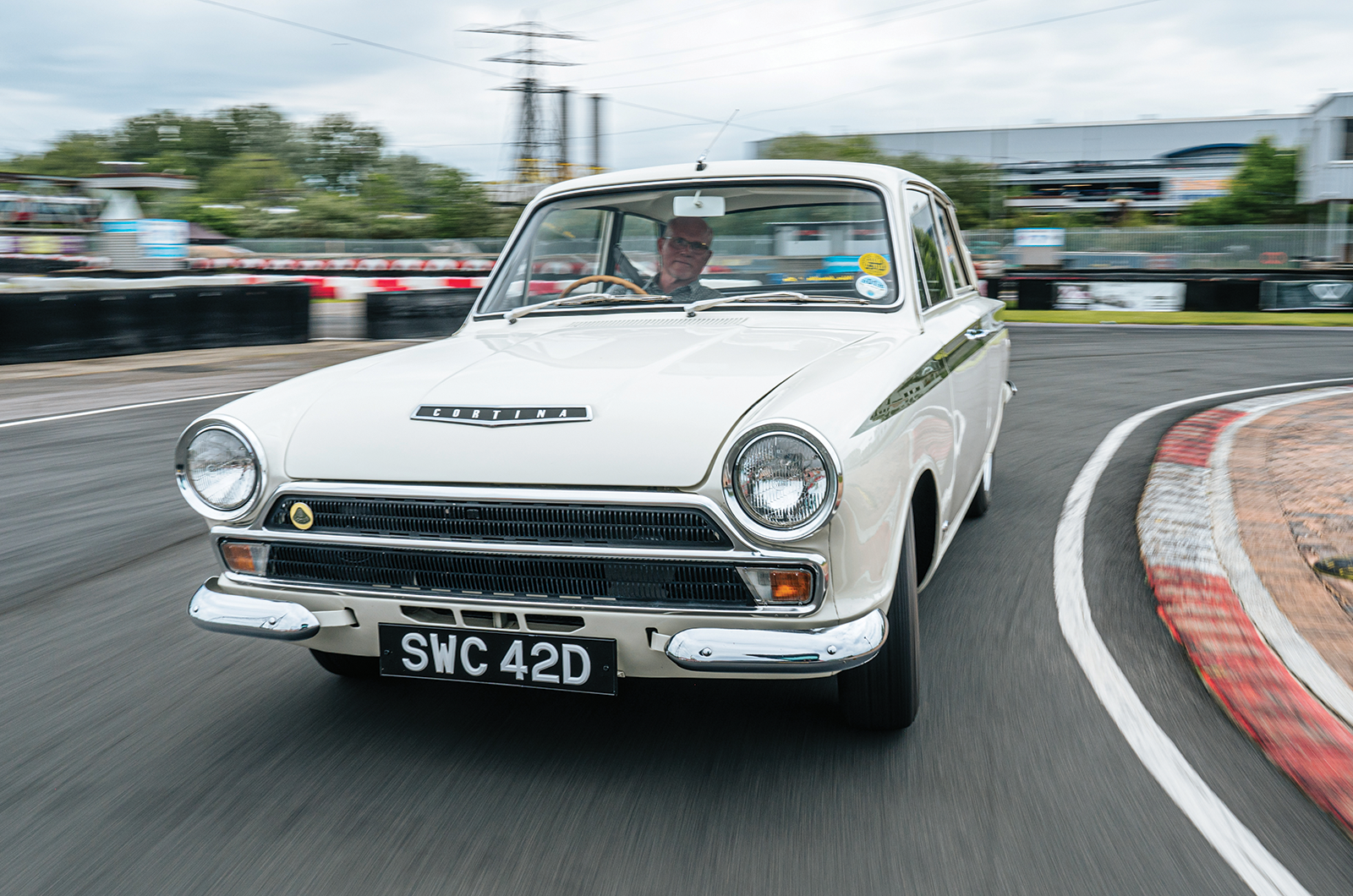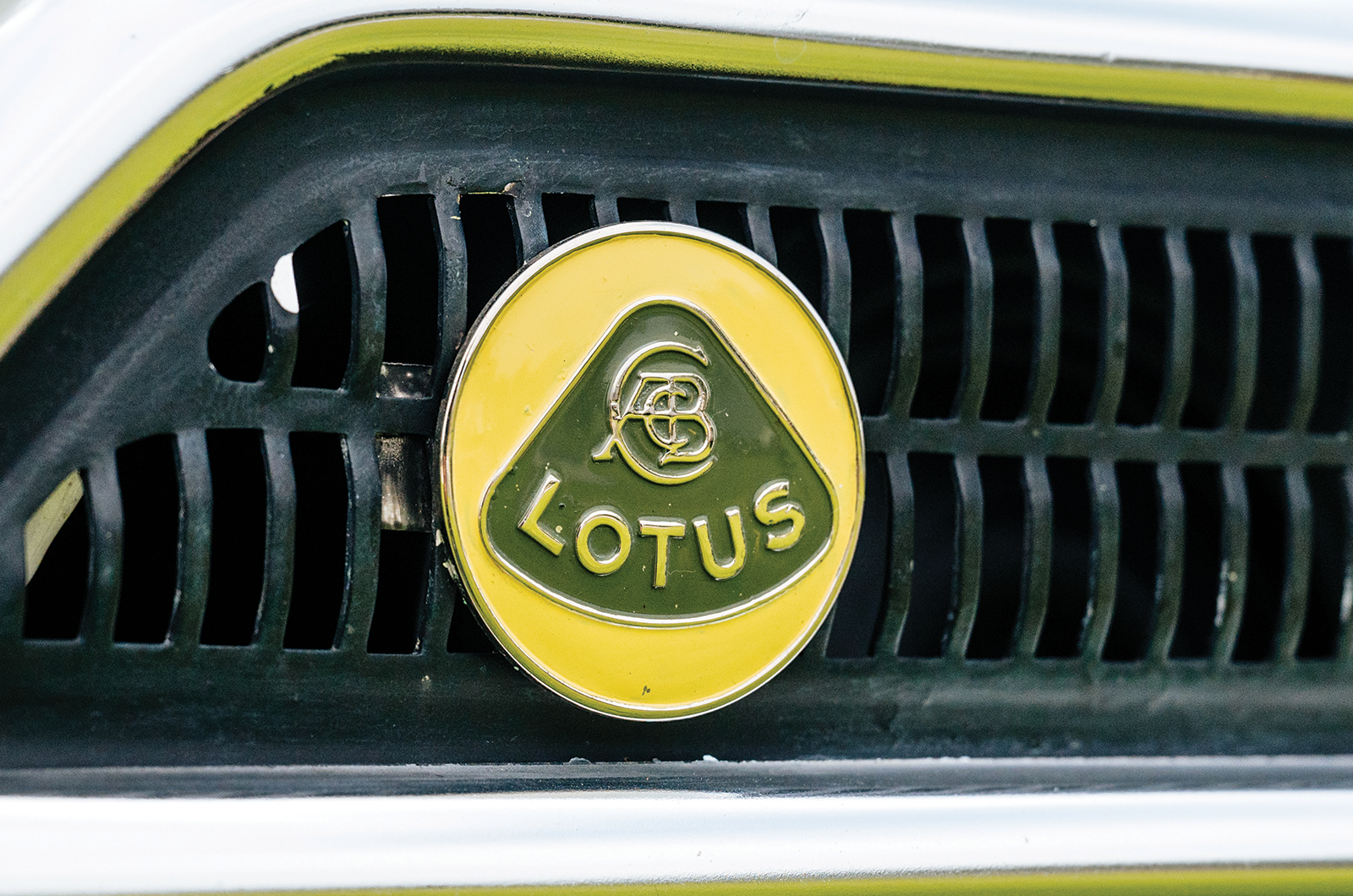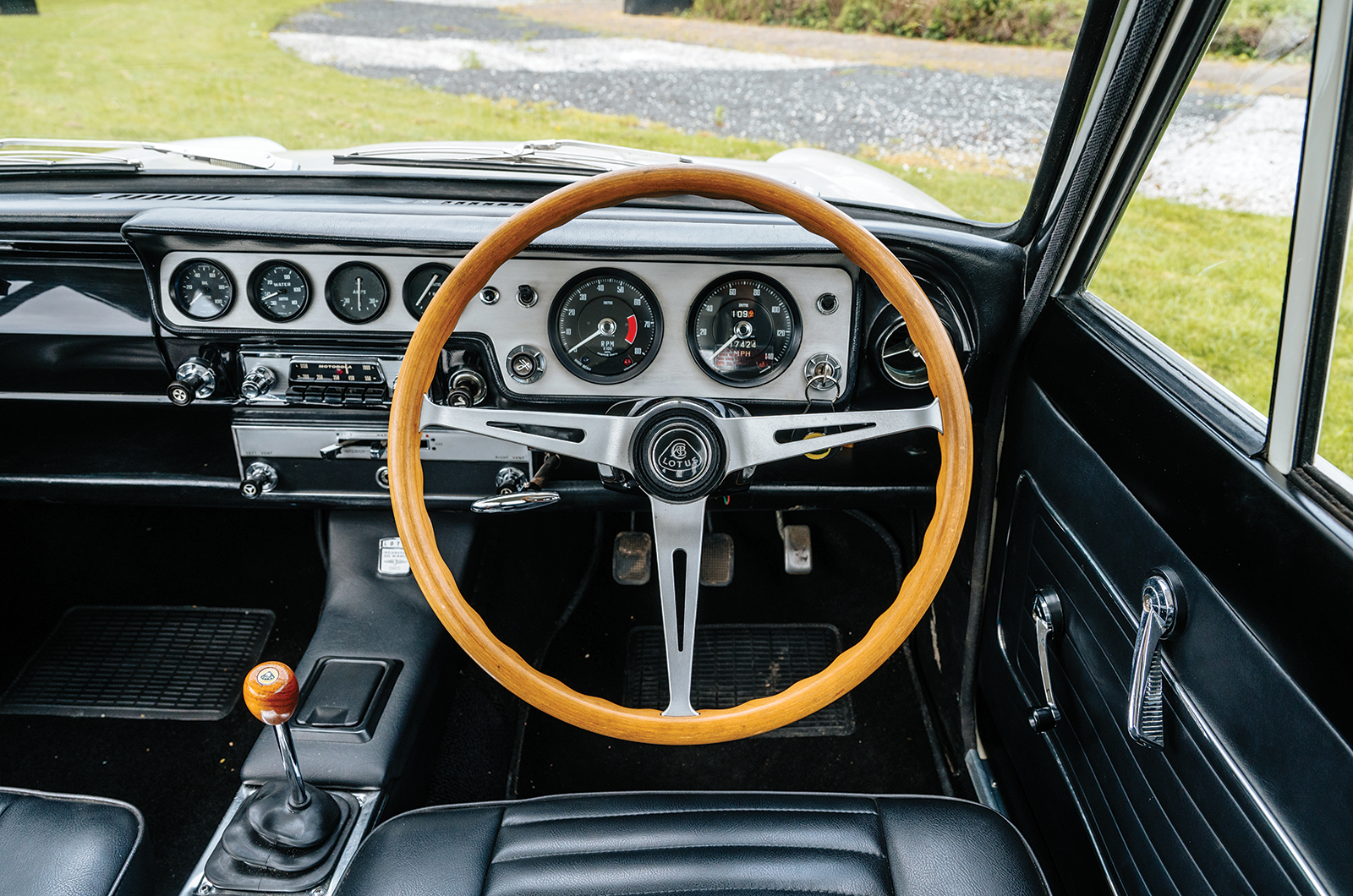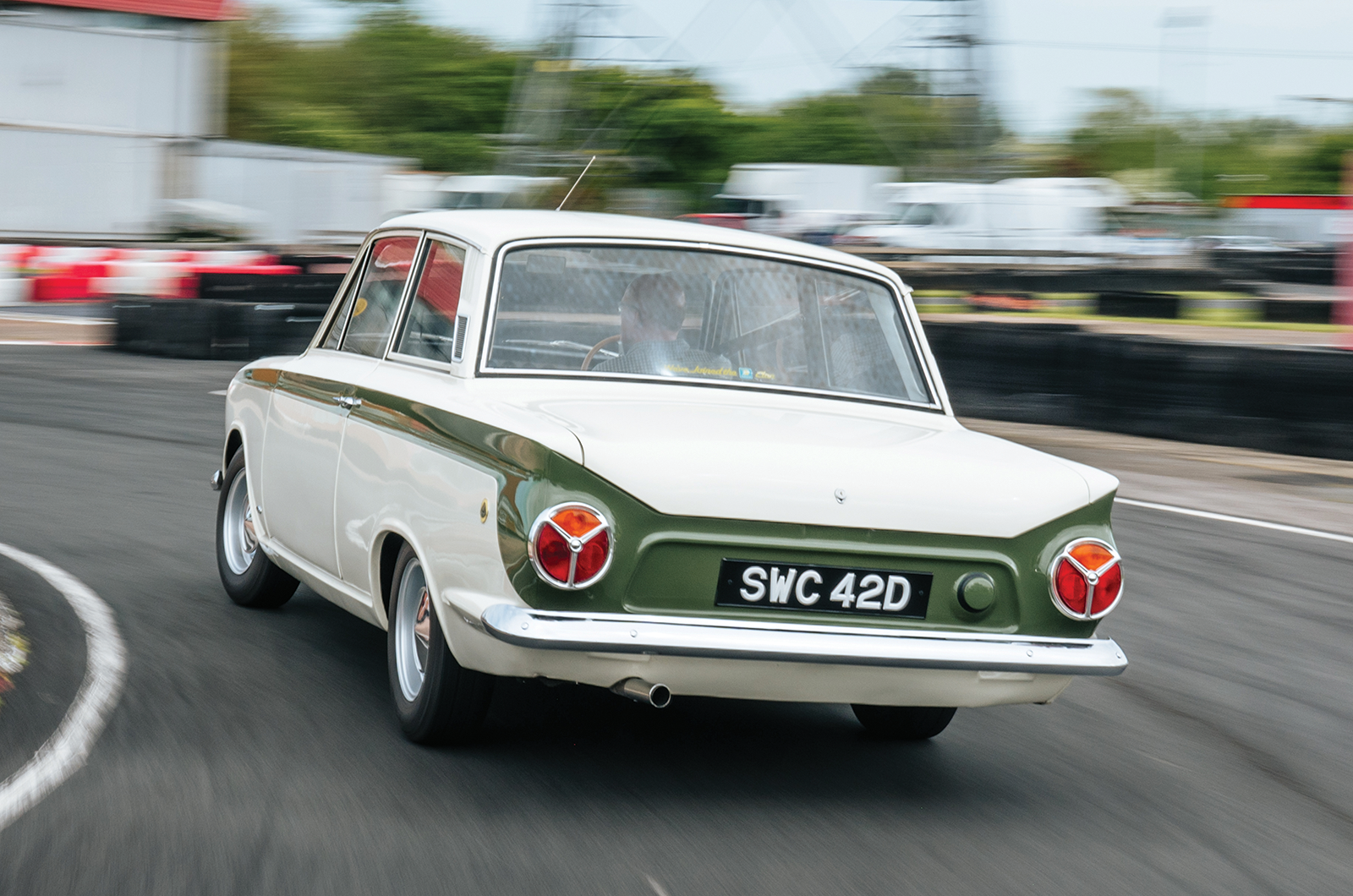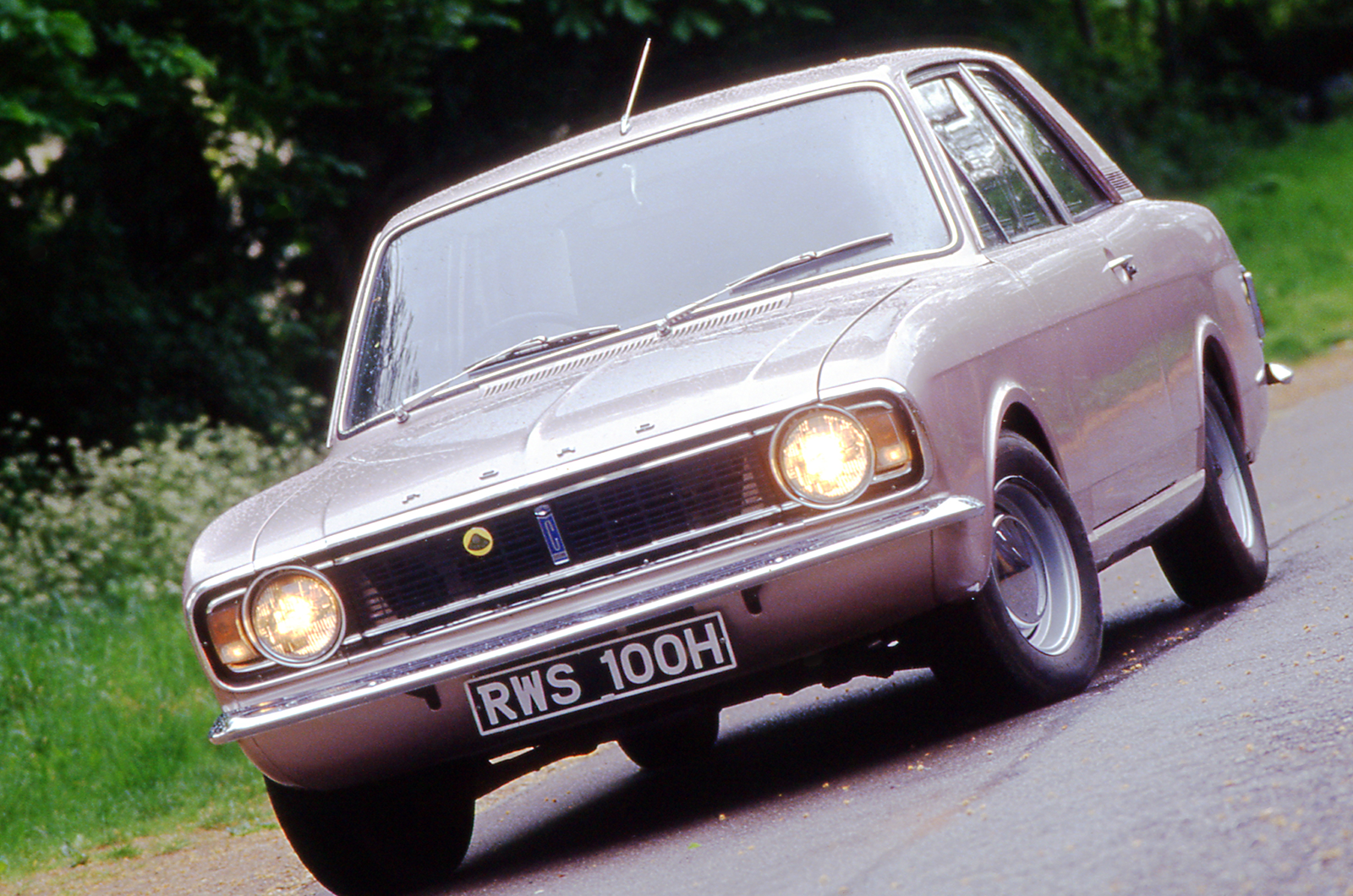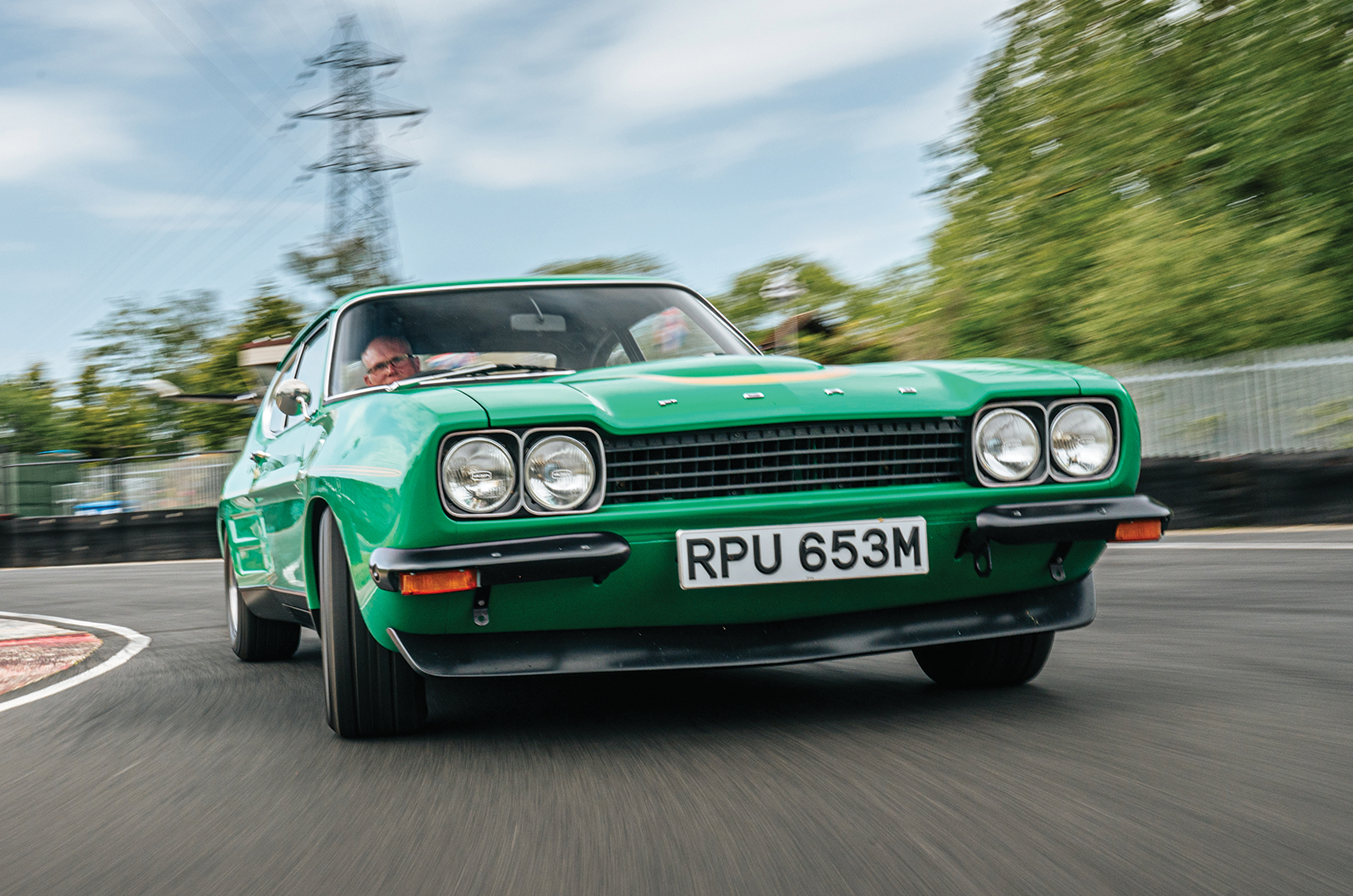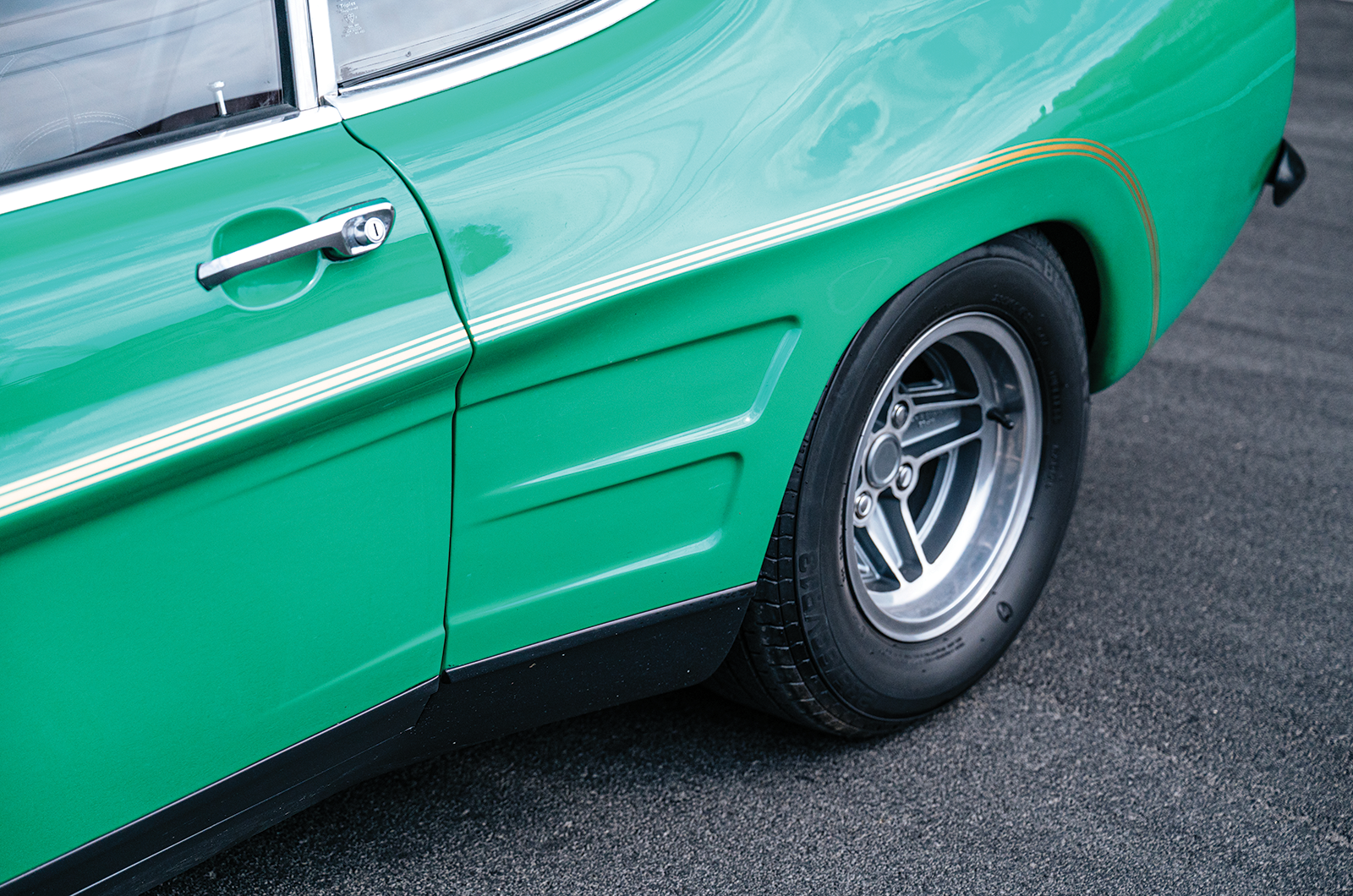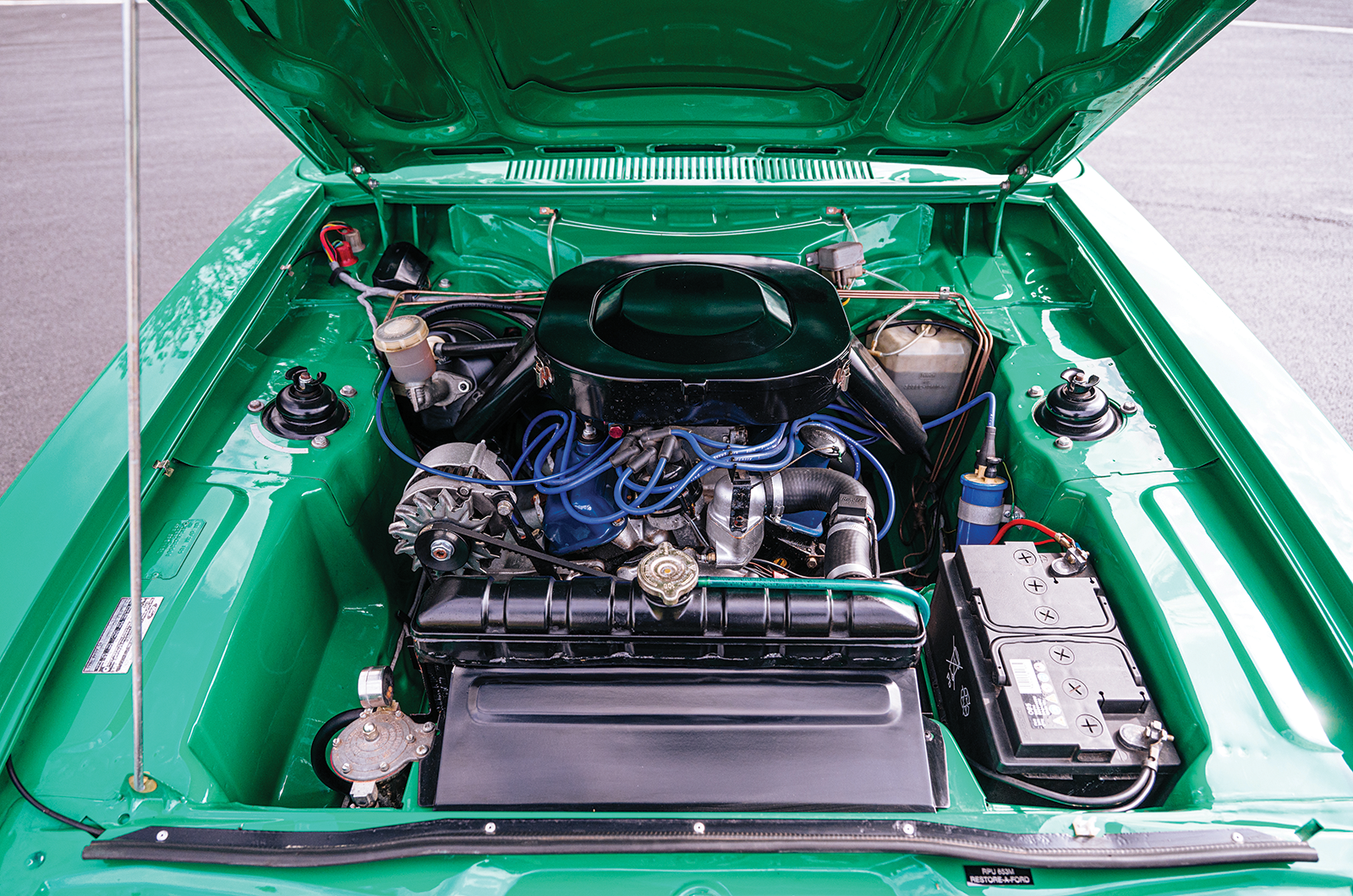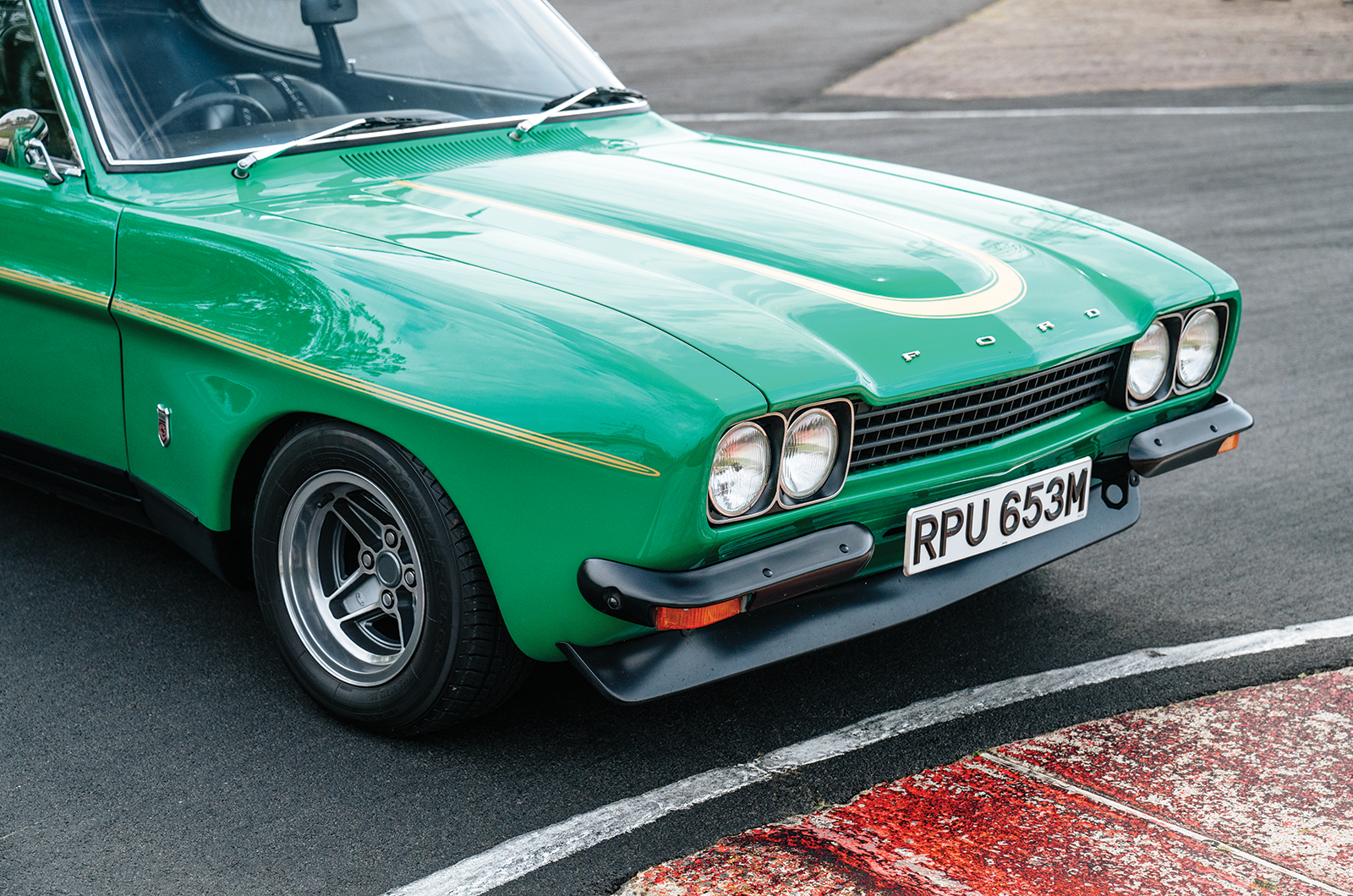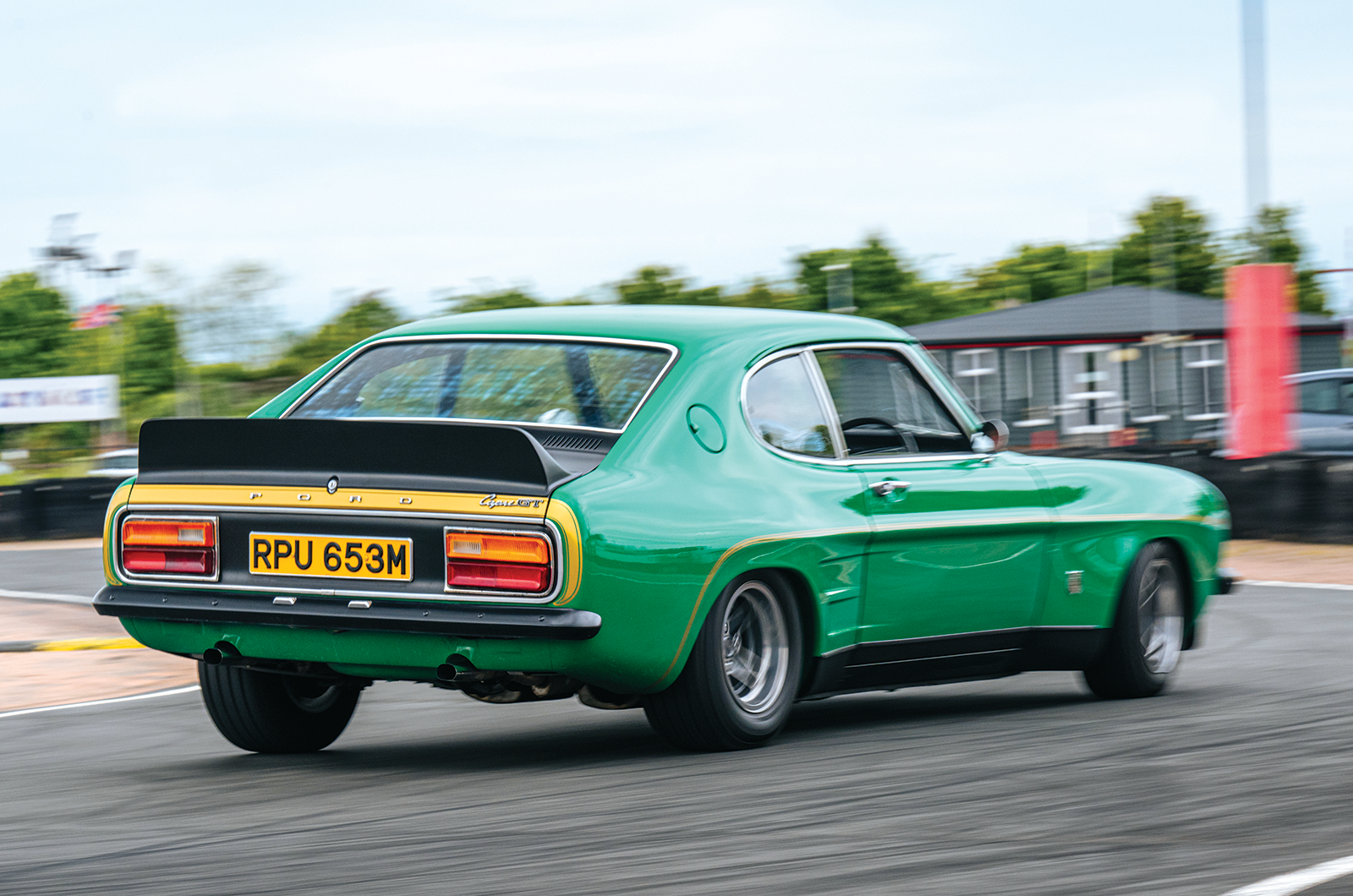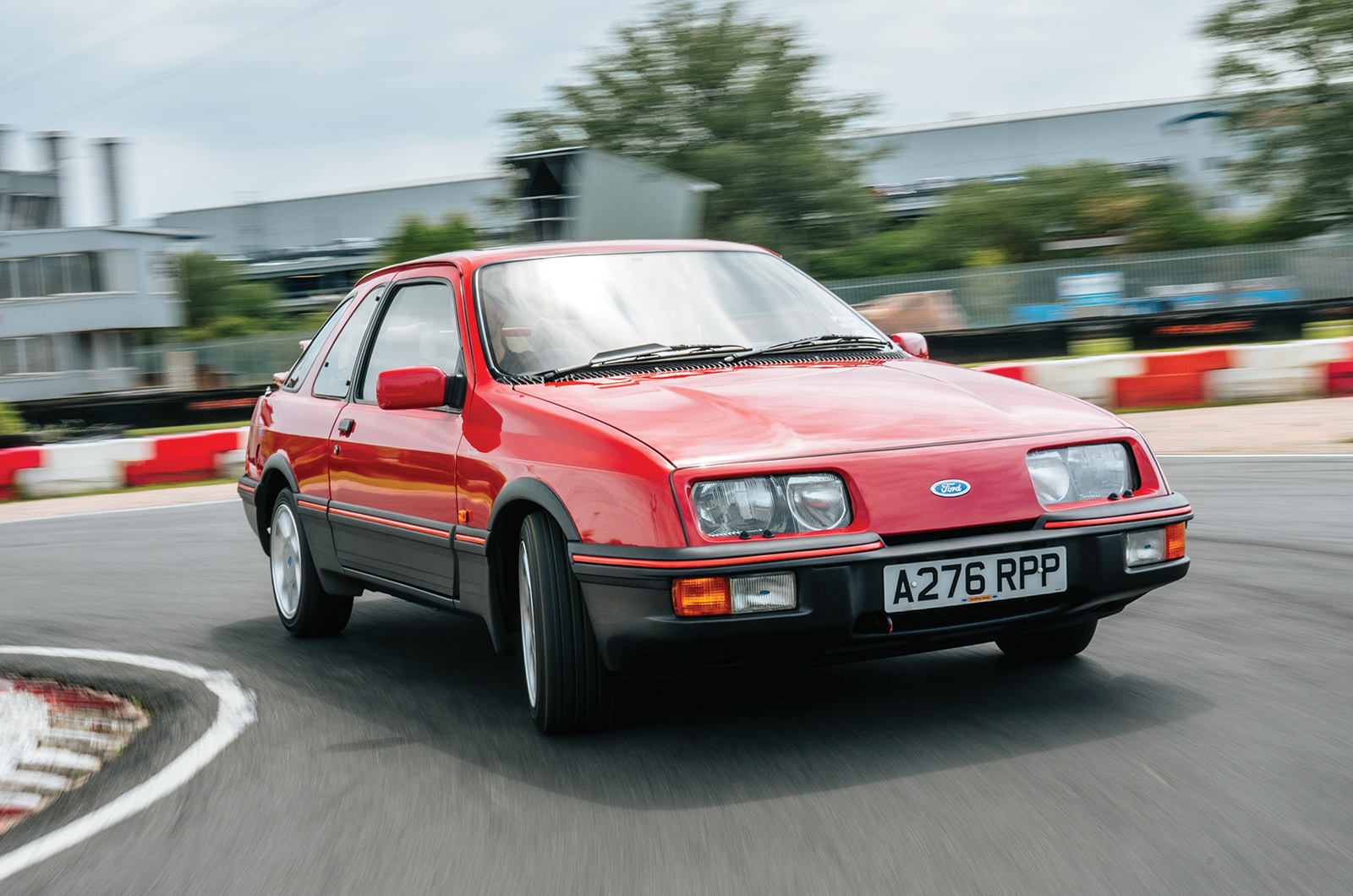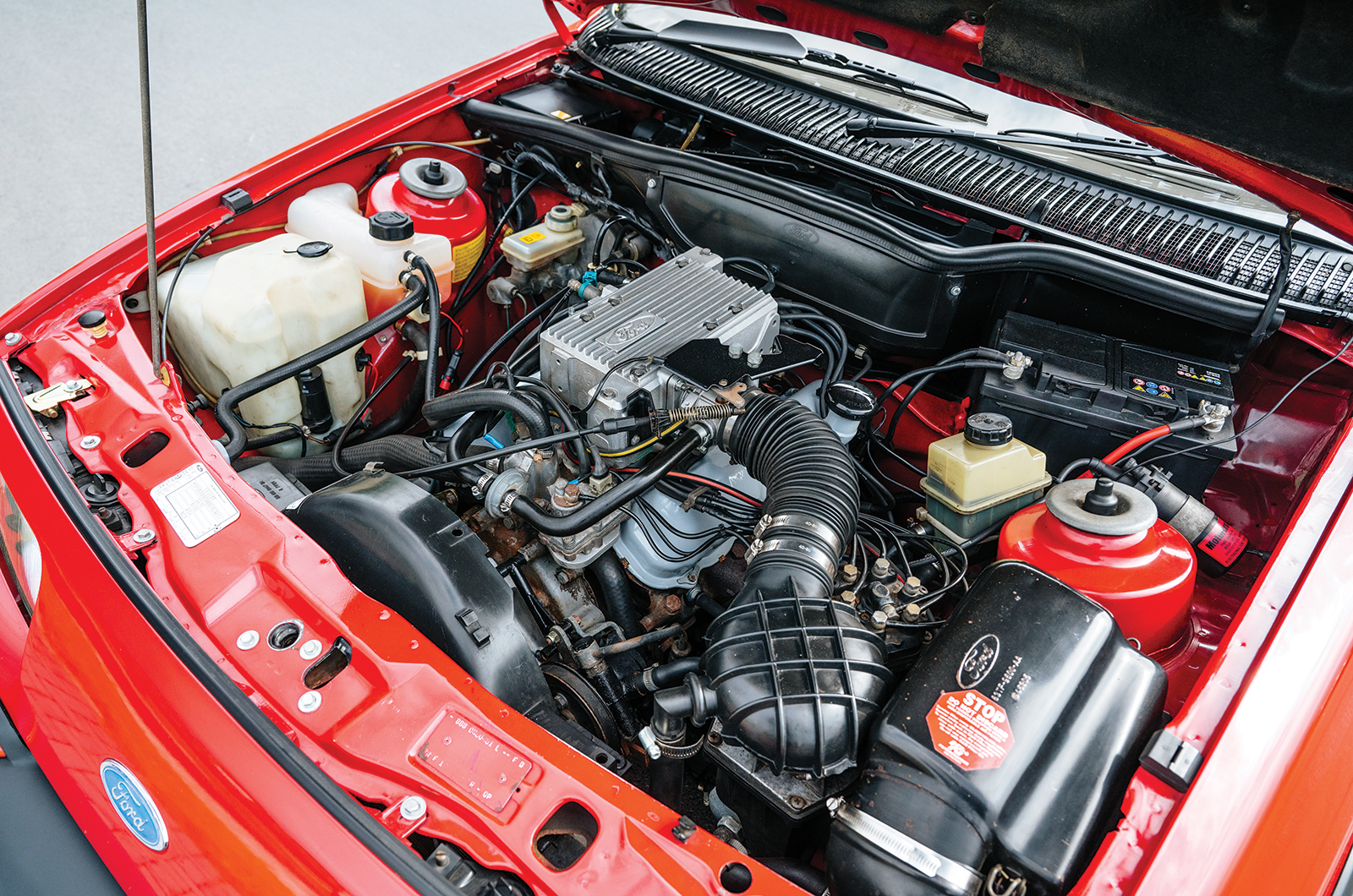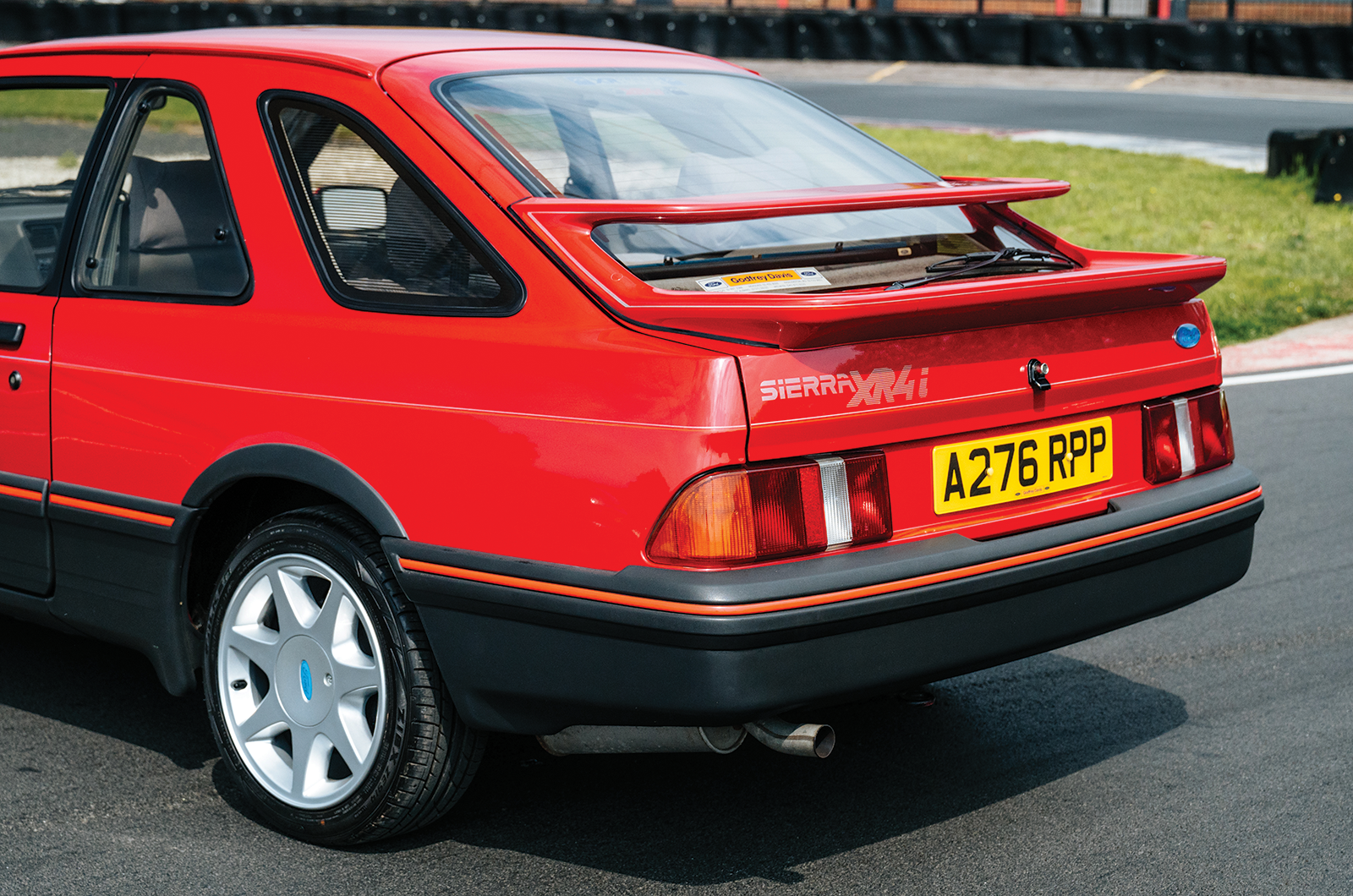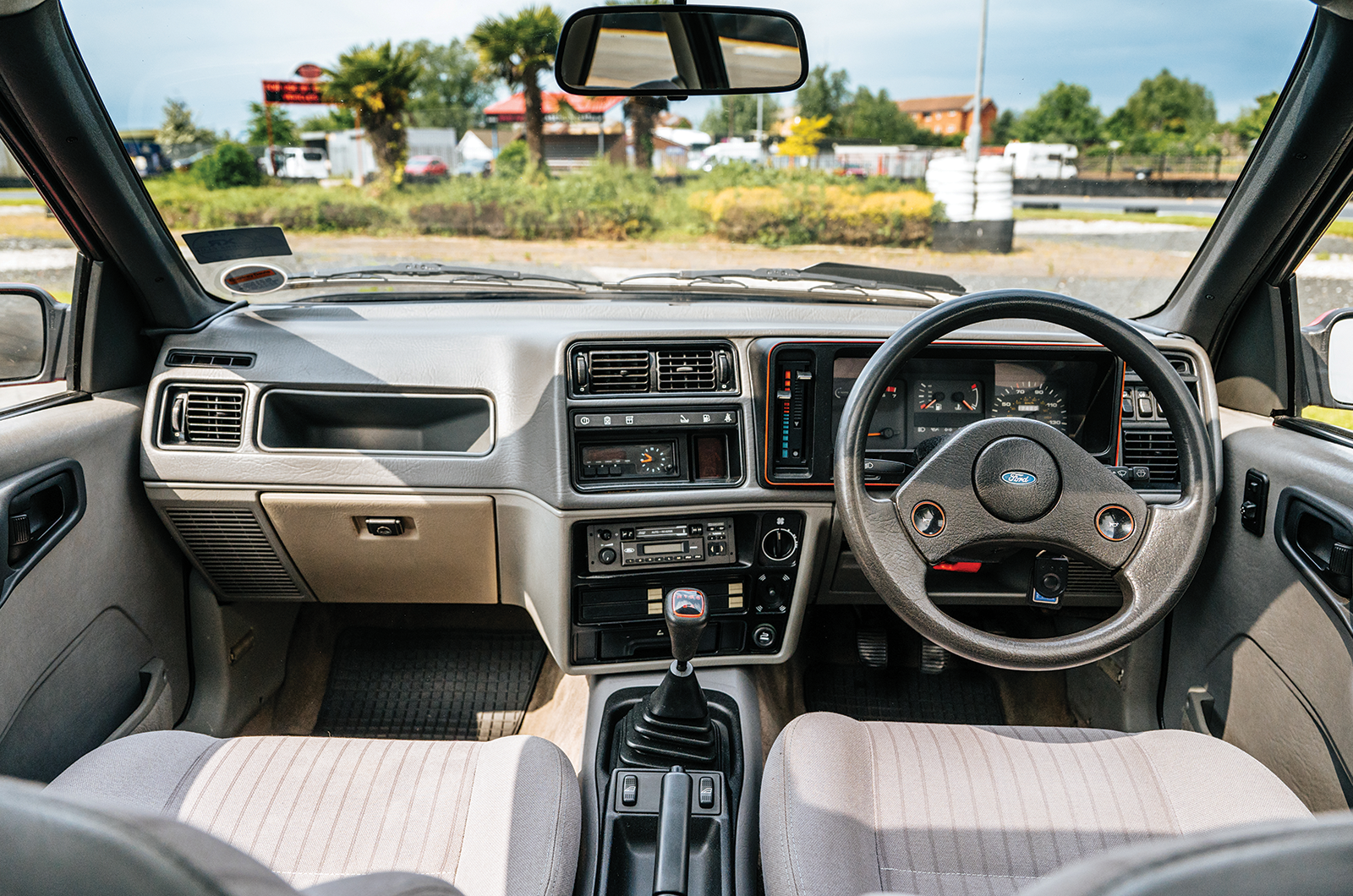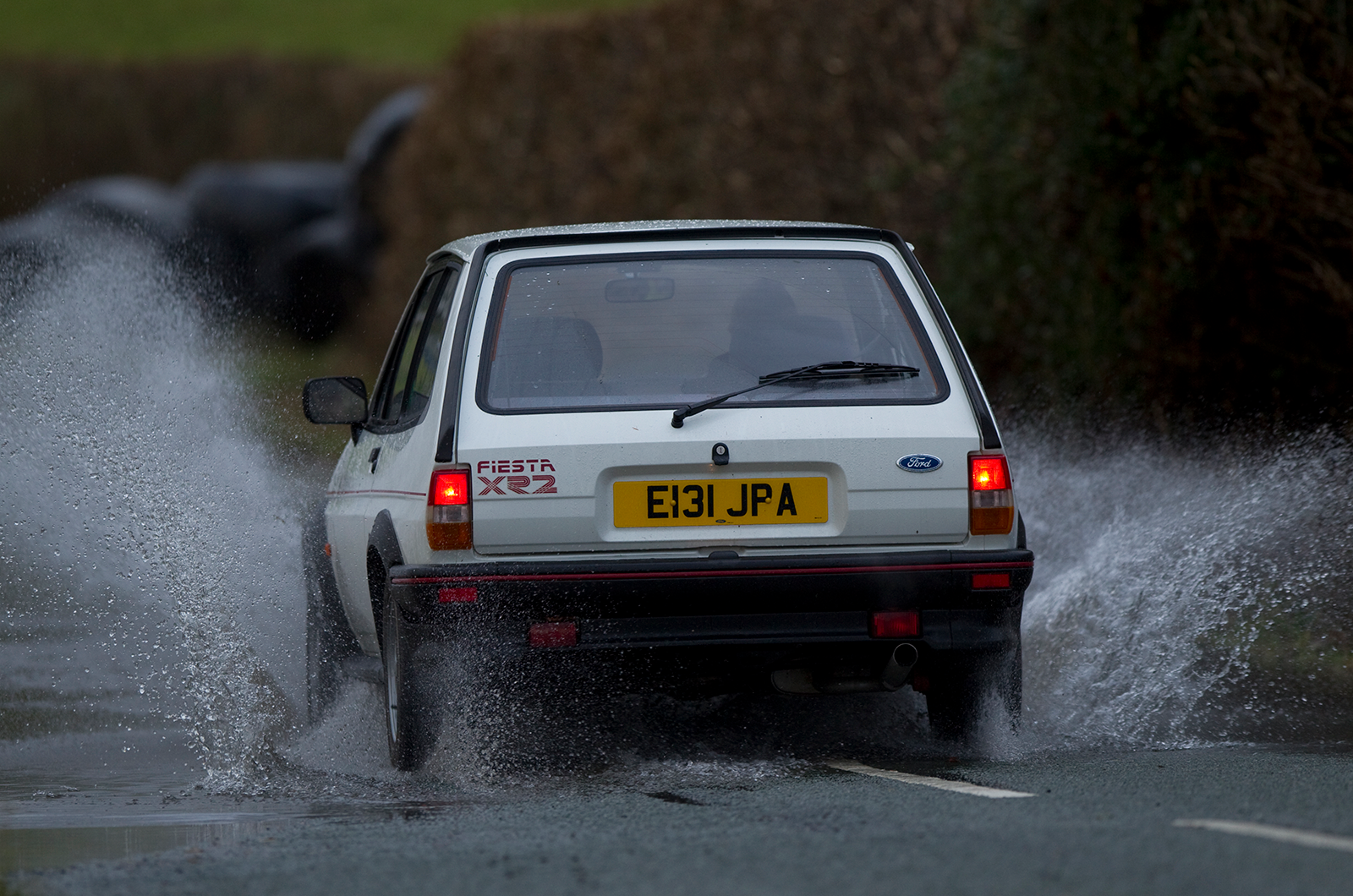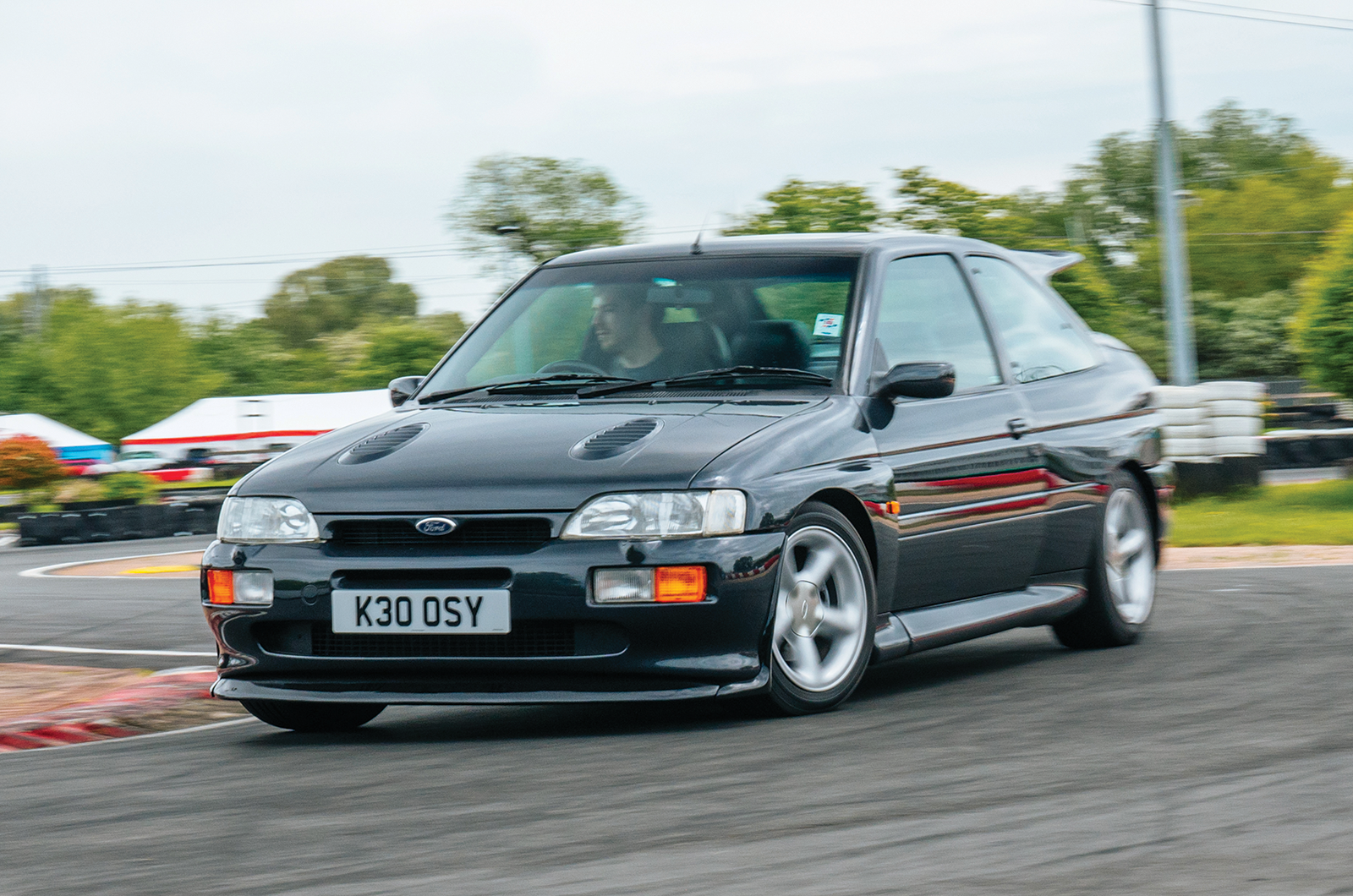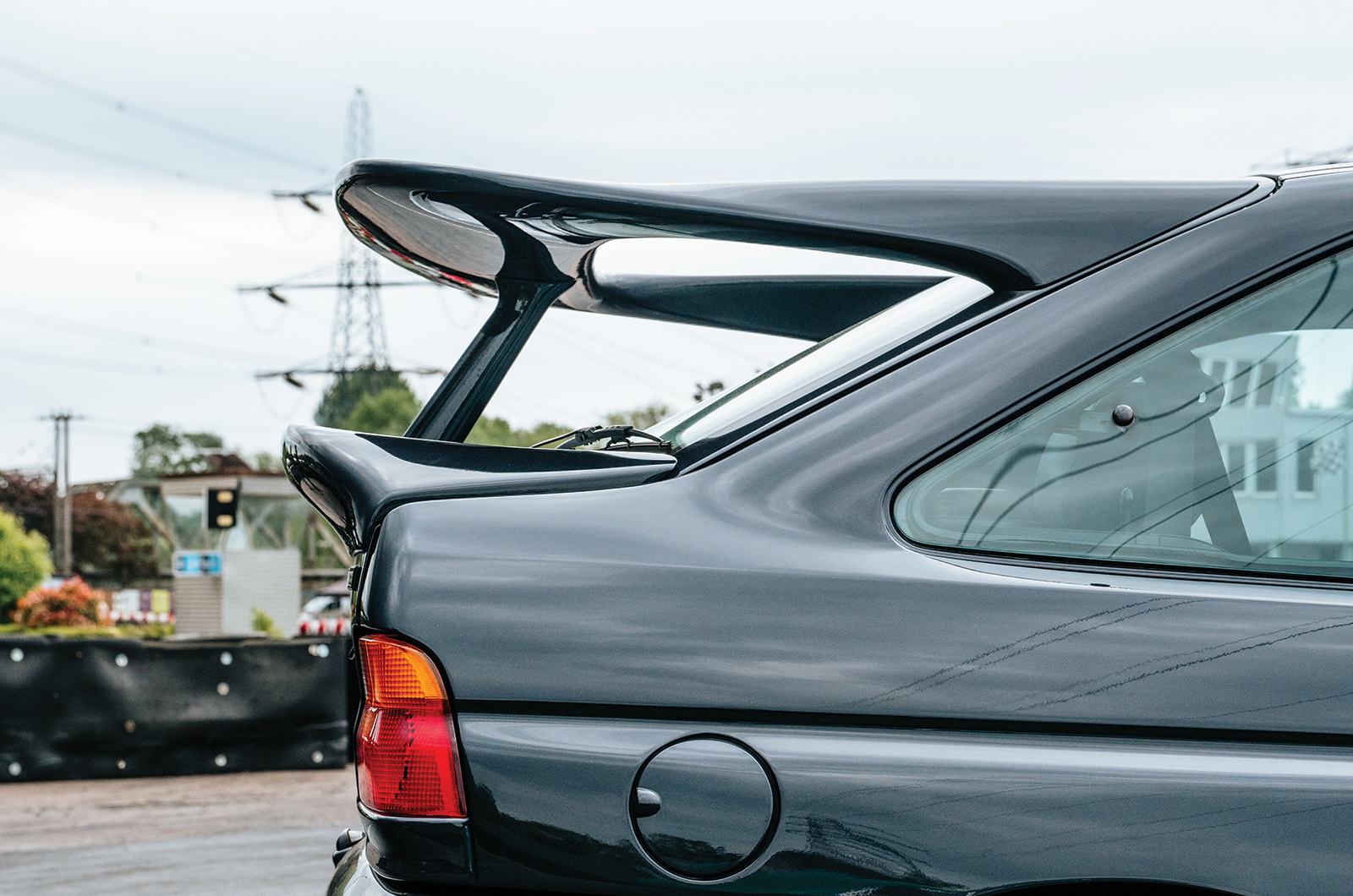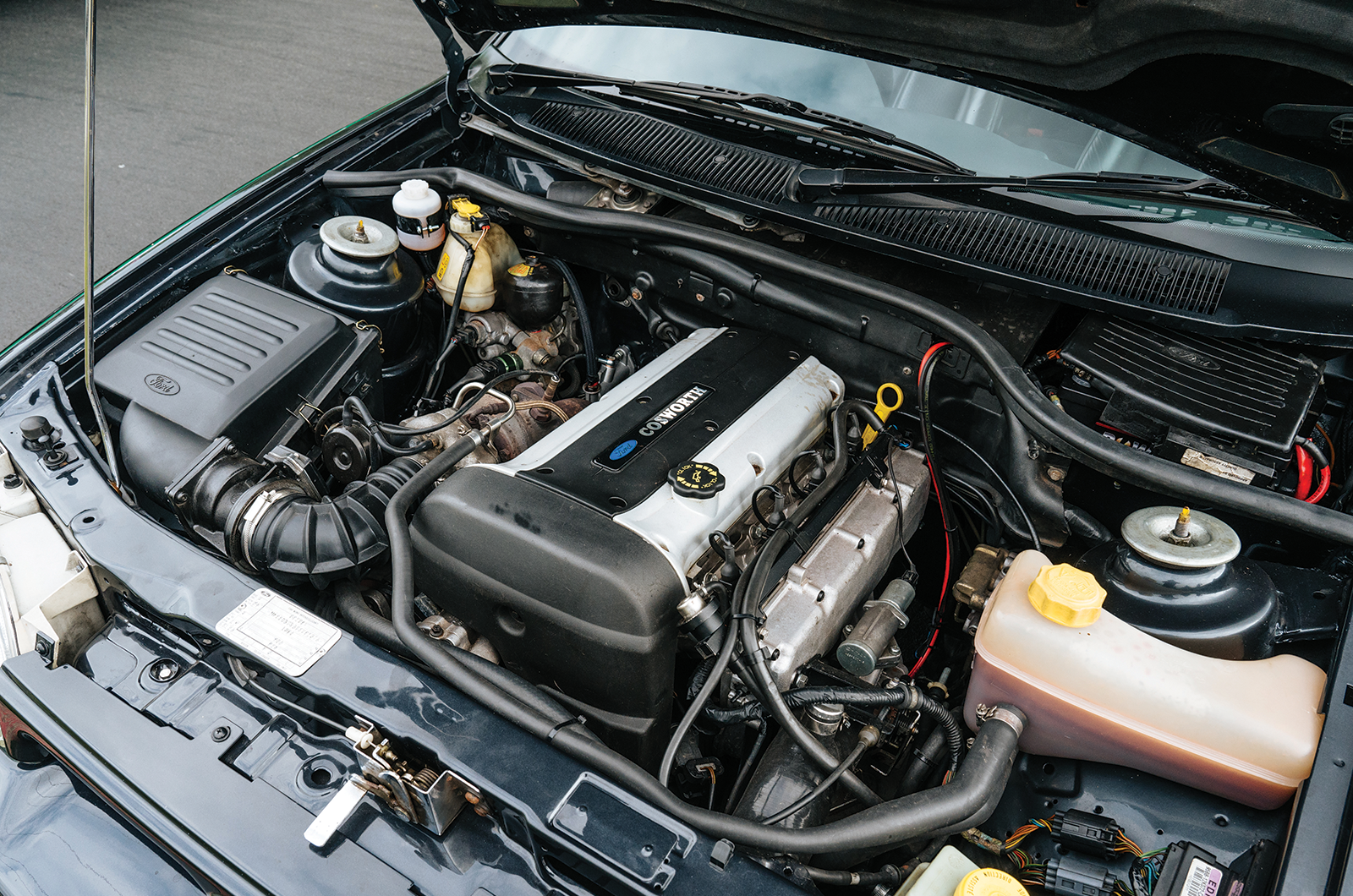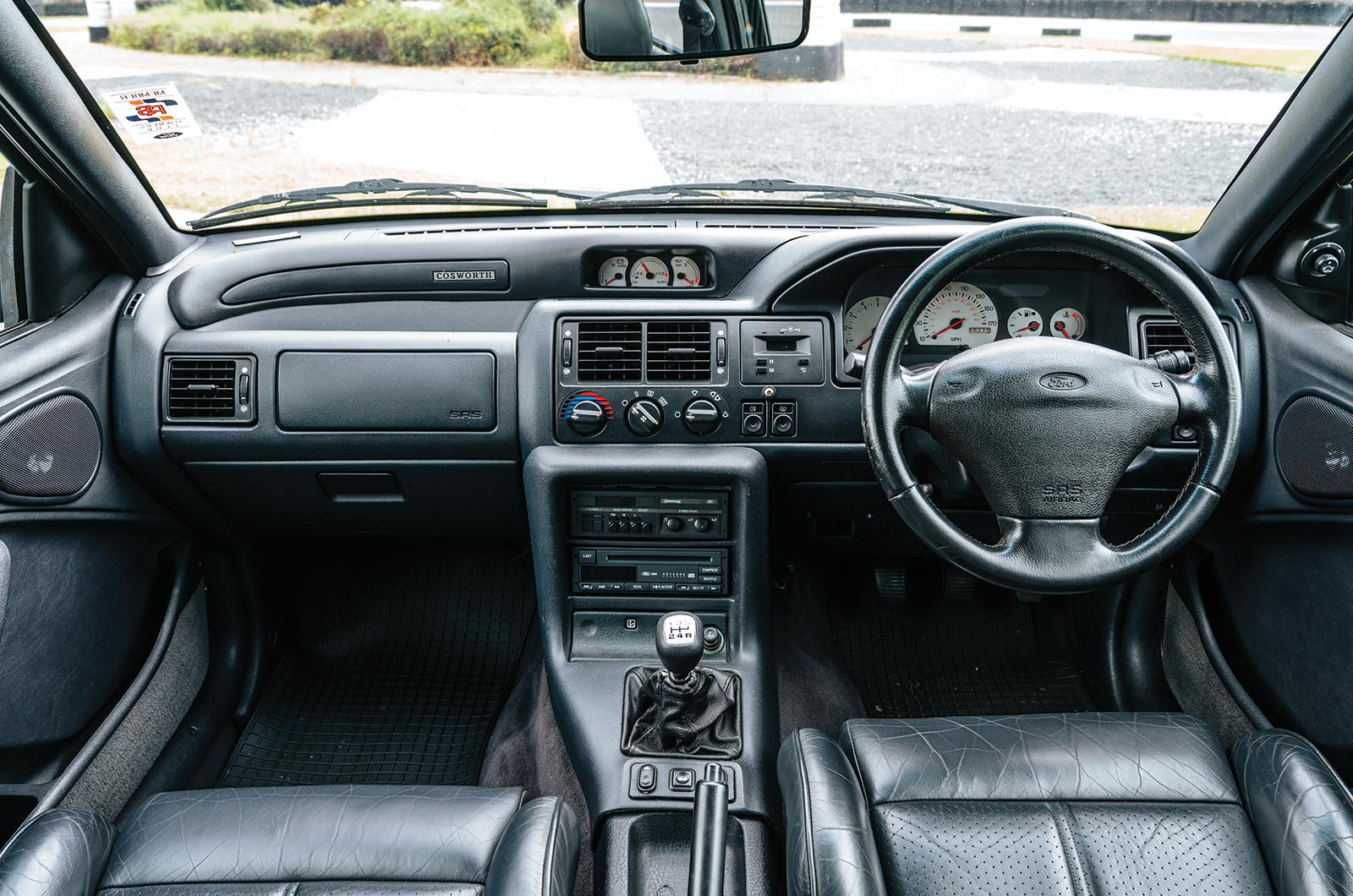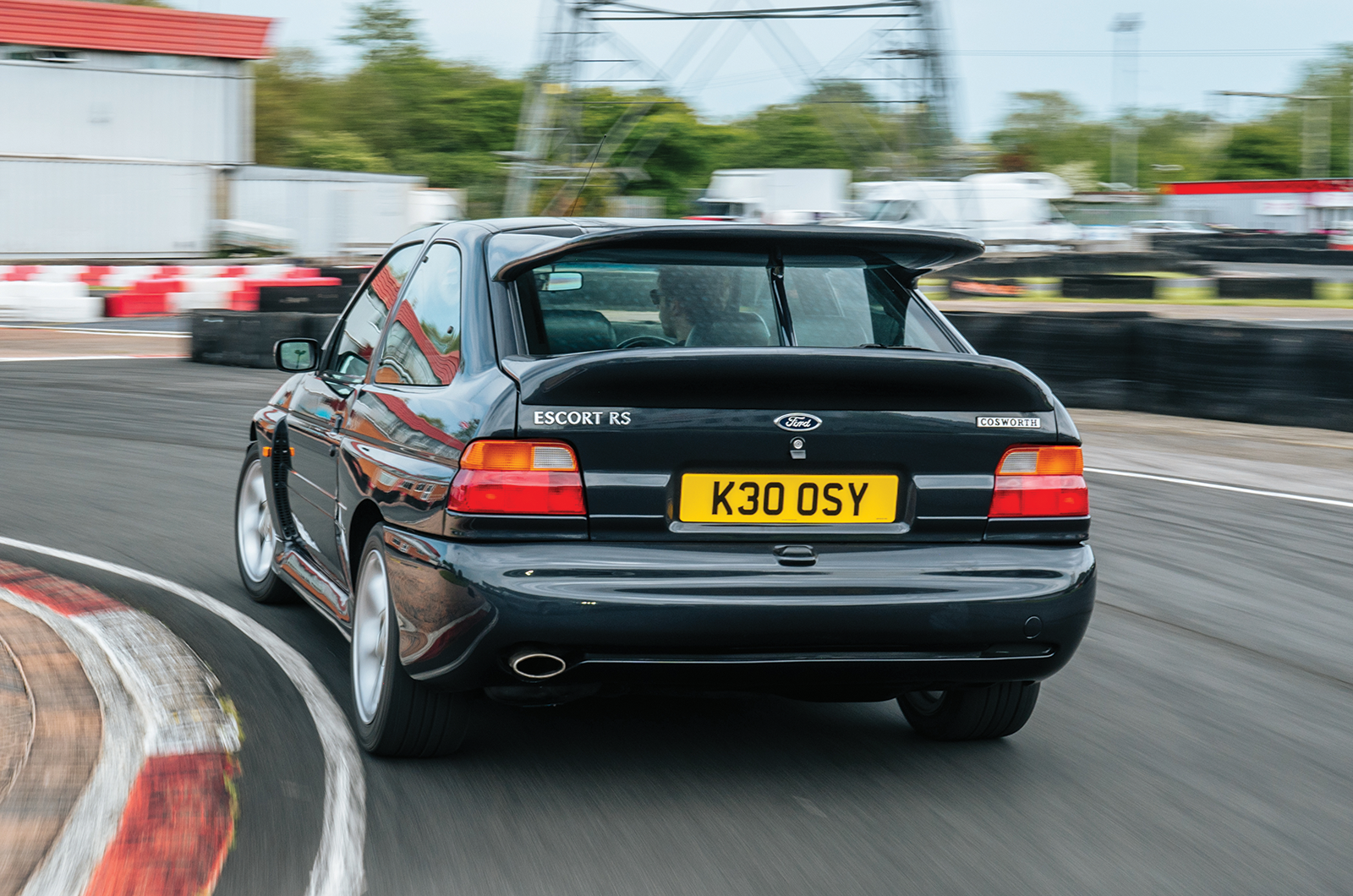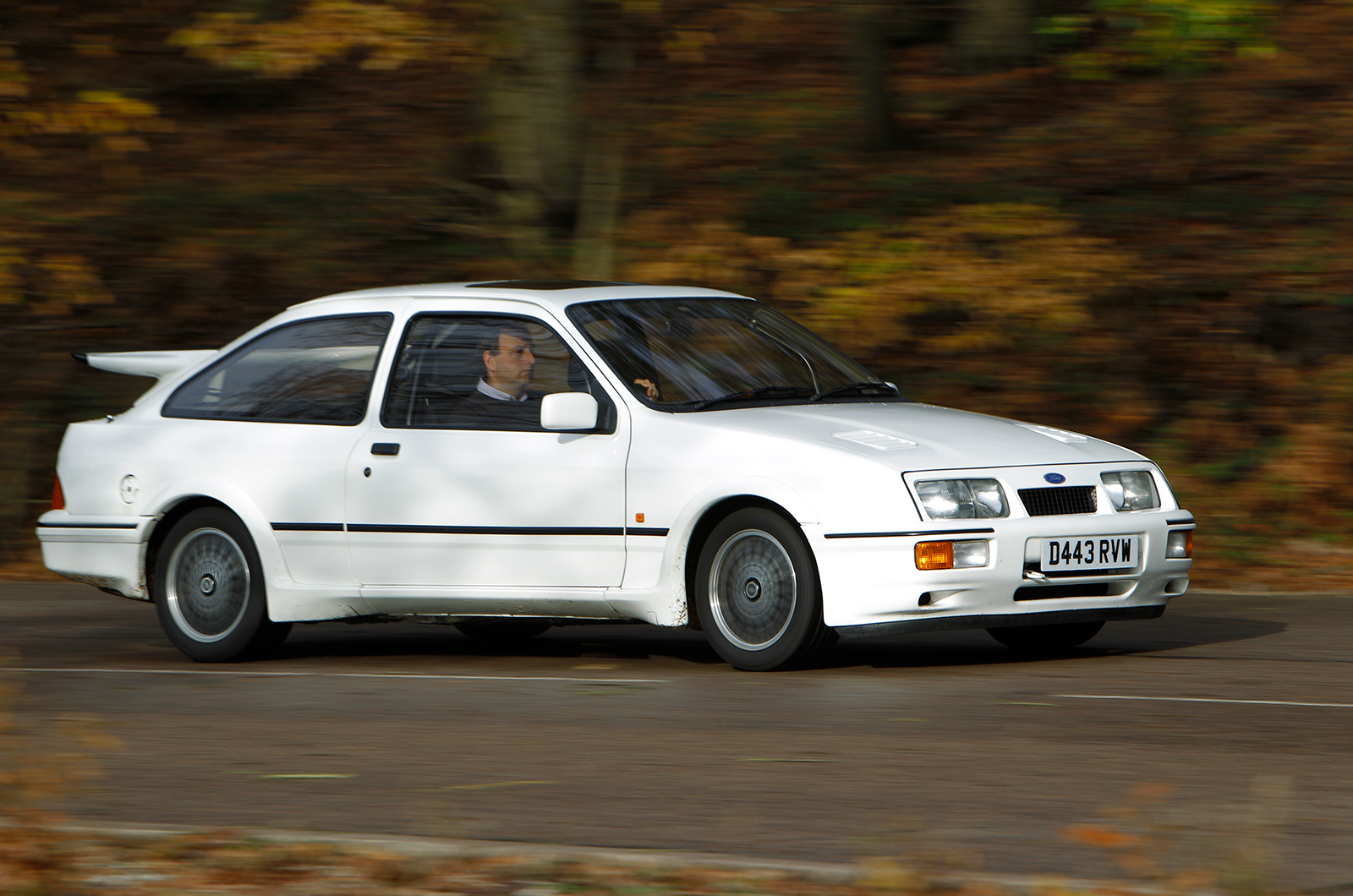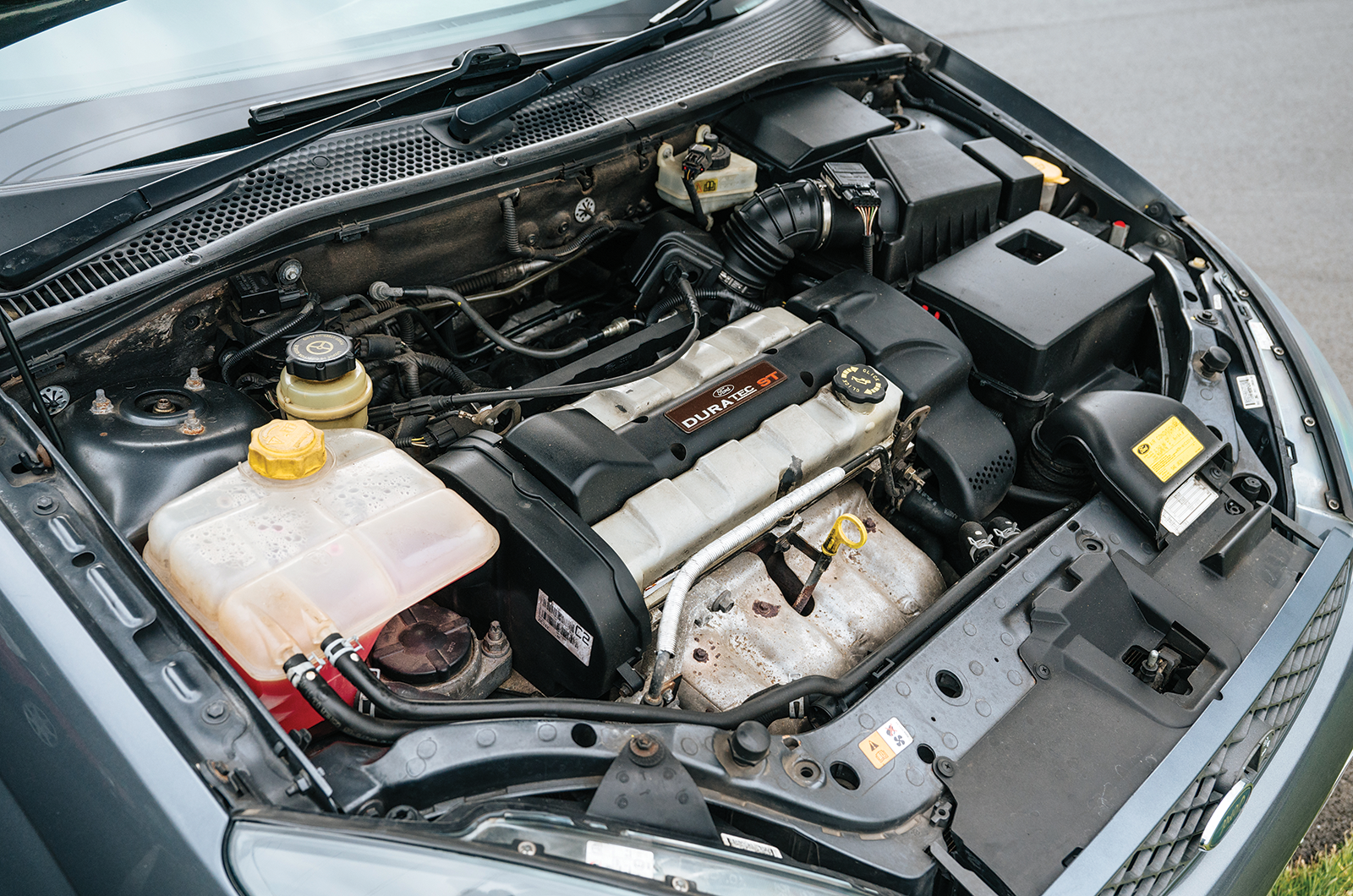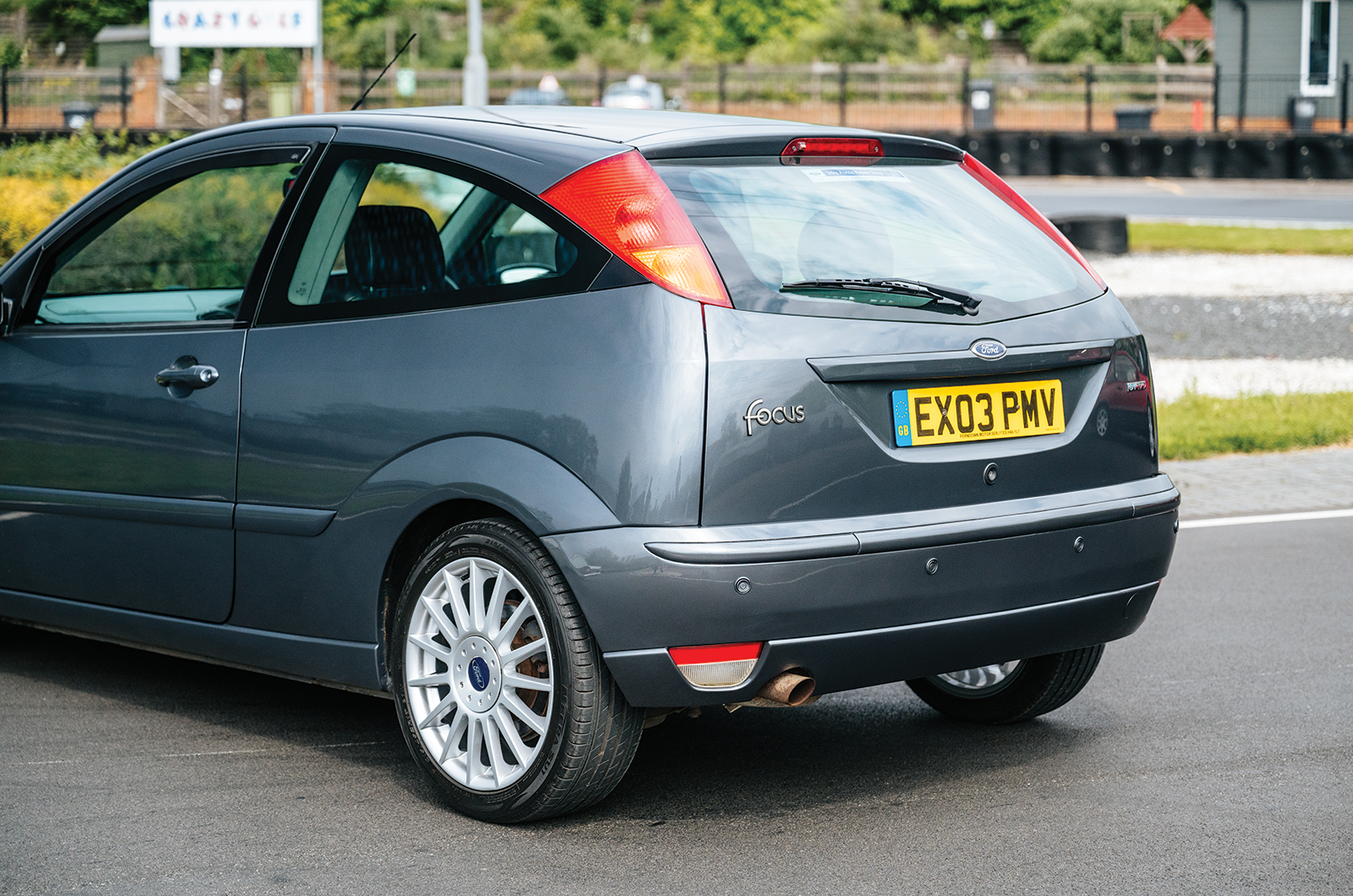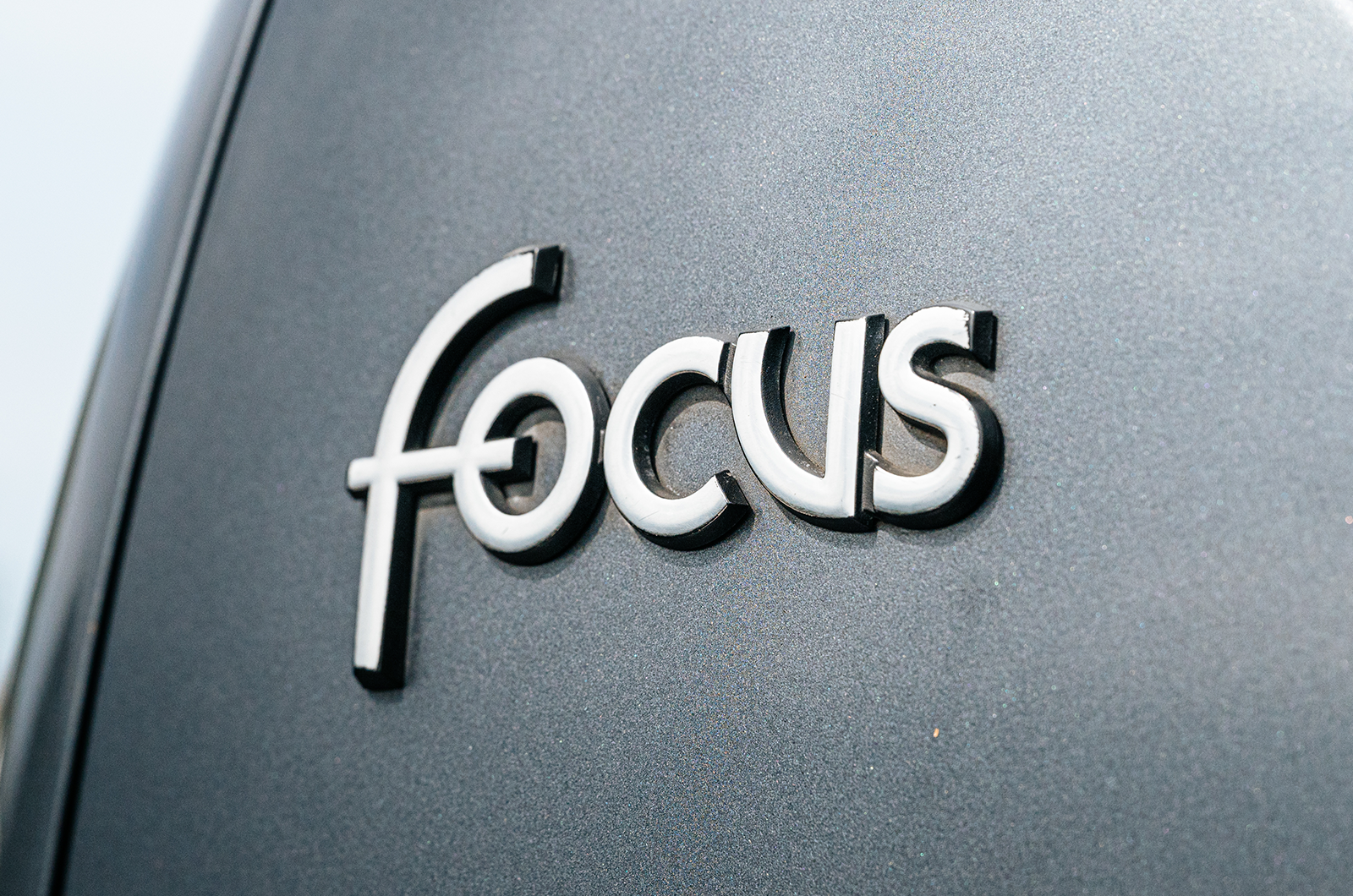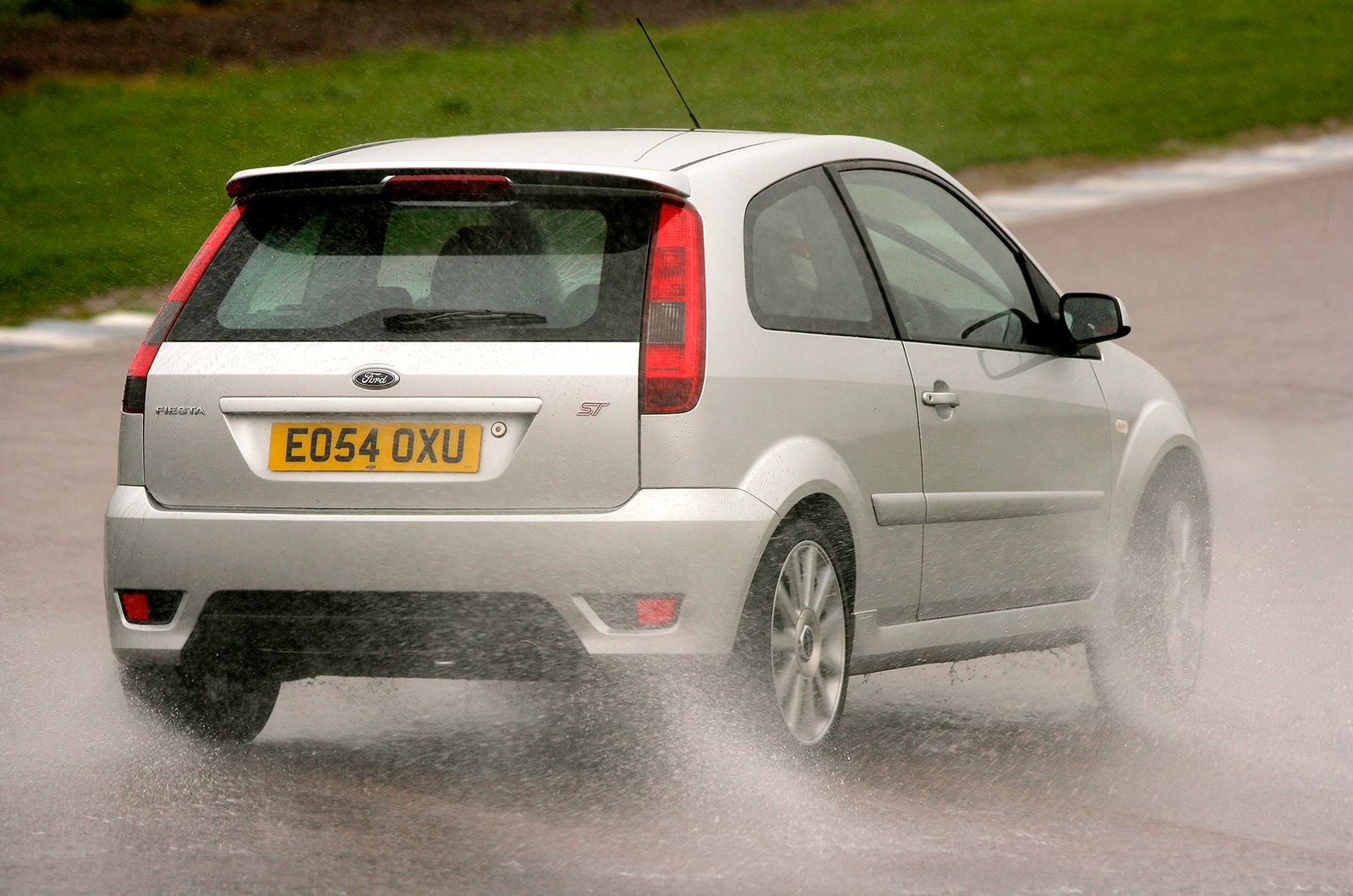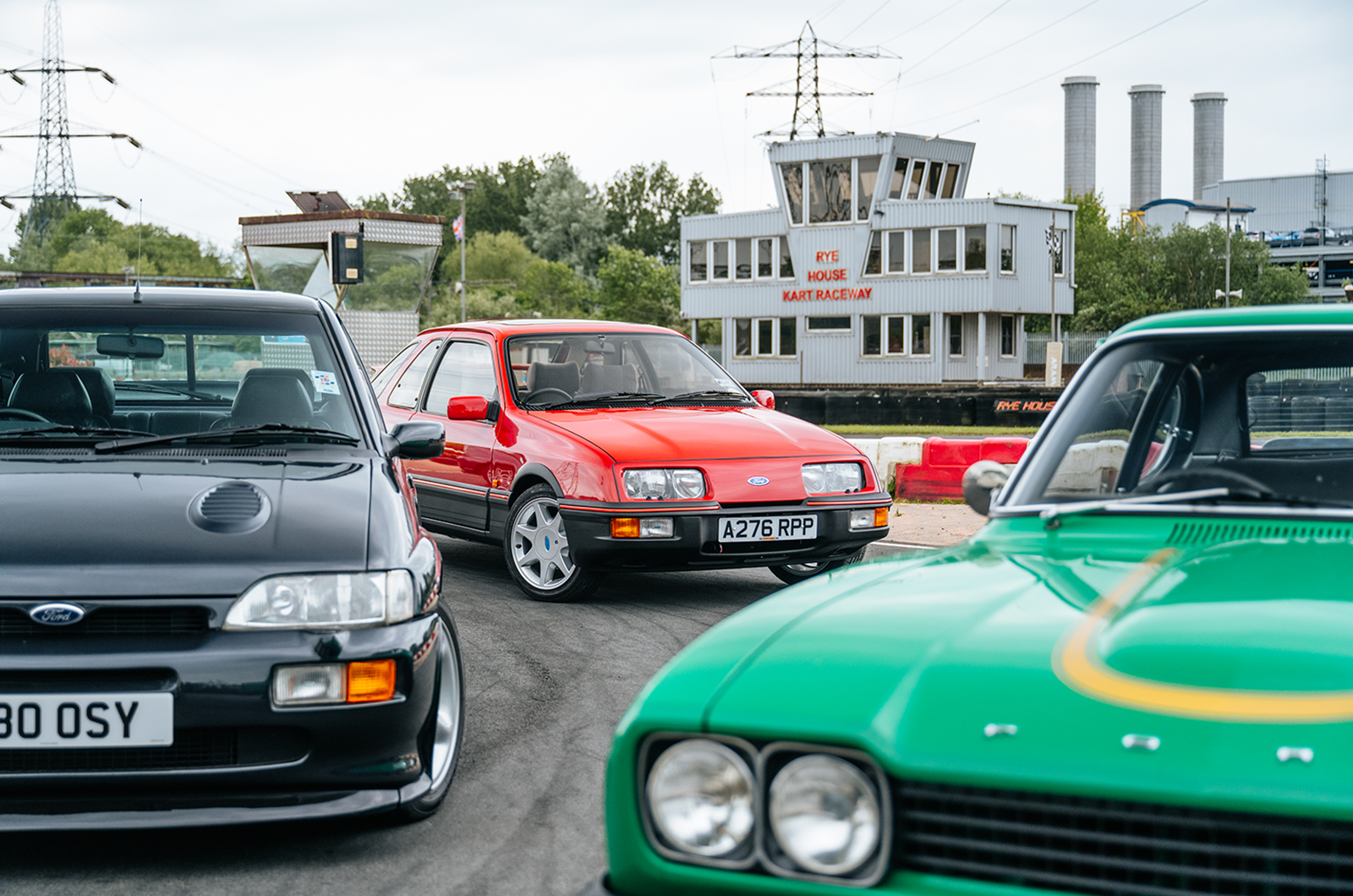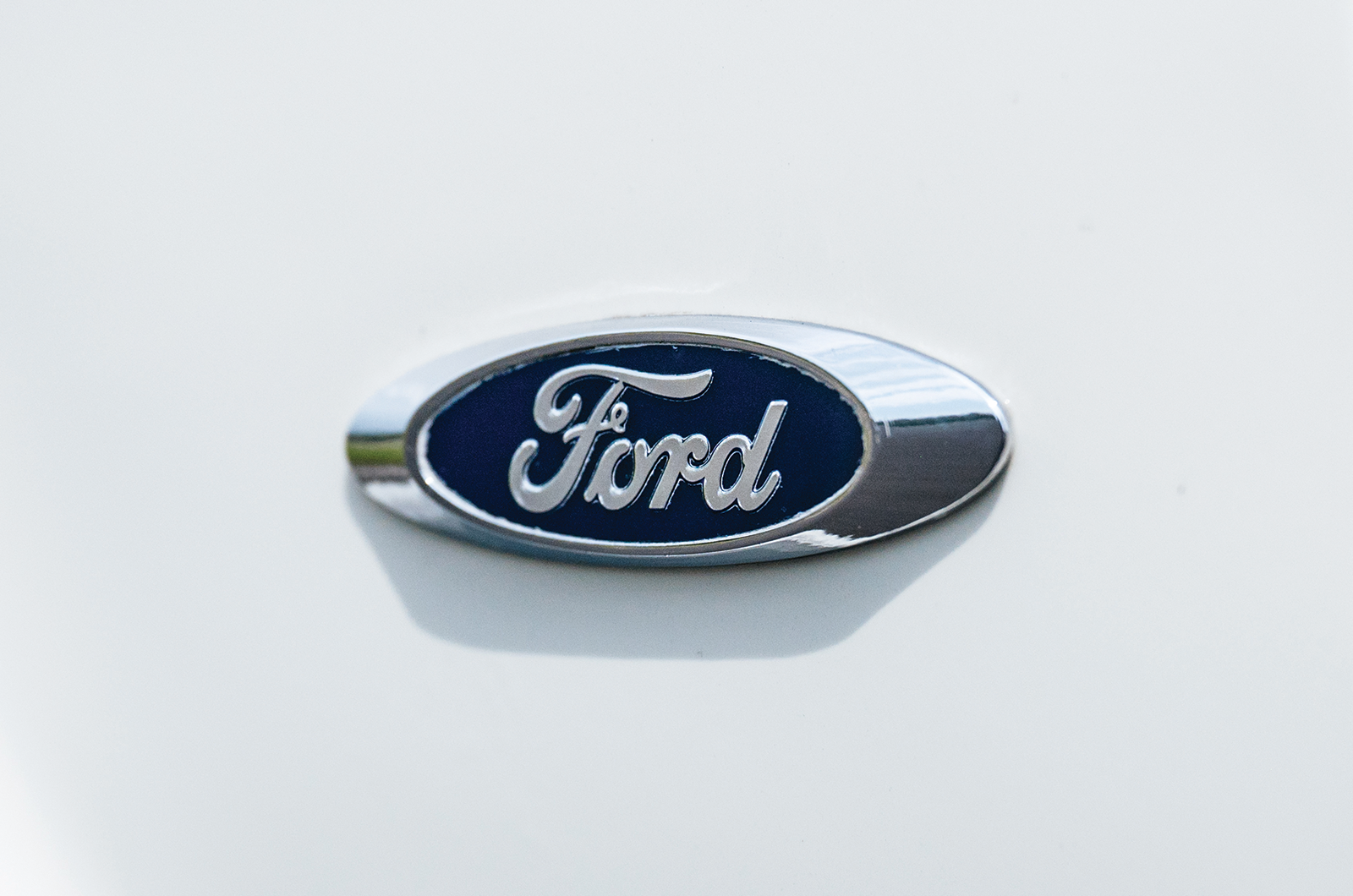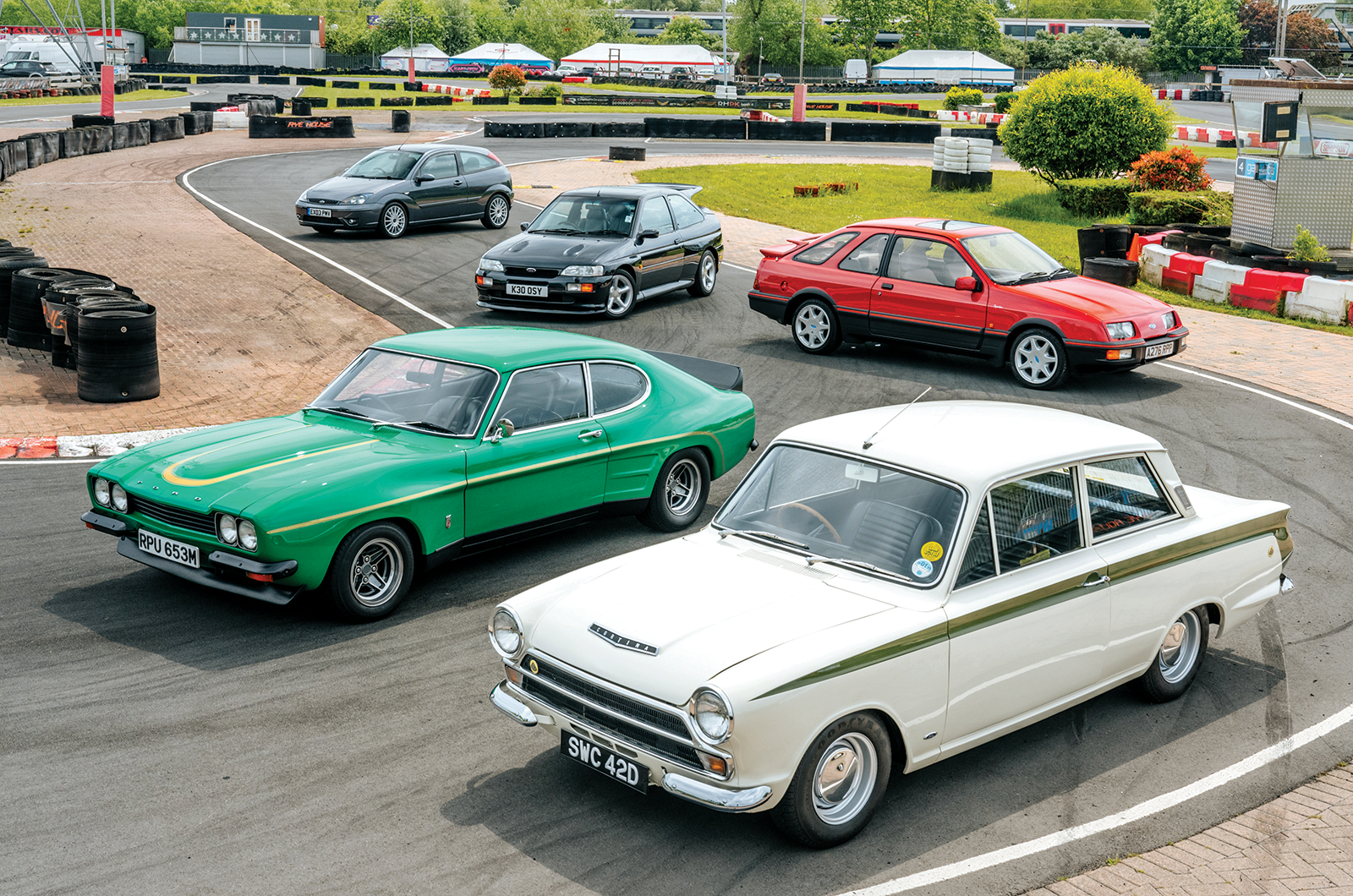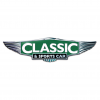Just 247 cars were built at Ford’s Halewood plant (plus six pre-production cars) during November and December 1973, and it soon became clear that the car was going to be a difficult sell, despite its motorsport links.
Discounting was an inevitable consequence but, even then, the last 50 cars had to be packed off to Australia after the well ran dry in Britain.
Chris Griffiths has owned his Modena Green RS 3100 since 1986, before which it had spent time as a hillclimb and sprint car.
The overbored Essex V6 engine benefits from a triple-carb conversion on this example
The most obvious upgrade is the addition of a ‘Cologne’ bodykit, a period option that replicated the looks of the RS 2600 racers.
It sets the car off perfectly – especially when complemented by the fat, non-standard 7½in-wide four-spoke wheels – looking like a racing refugee for the road.
Chris’ Capri was also fitted with Ford’s triple-carb conversion in the ’70s, and since then its keeper has had the cylinder heads ported and higher-lift Ric Wood camshafts installed, upping power to 235bhp.
Given that the RS 3100 weighs little more than 1100kg (based on GXL data), that should make for an enthralling drive.
Belting yourself into the well-padded vinyl bucket seats, apart from an aftermarket four-point harness you could be in any regular Capri.
The Ford Capri RS 3100’s quad lamps add aggression
Ahead is a large slab of an instrument binnacle containing two main clocks for revs (reading up to 7000rpm) and speed, with ancillary dials on either side.
The bland, two-spoke steering wheel is an incongruous item for a homologation special, and looks as if it’s been plucked from a 1300L.
But, lack of cabin ambience aside, the RS 3100 redeems itself with a turn of the key.
The Essex V6 is deep-throated and gloriously old-school, compared with the note of the more anodyne-sounding Cologne unit fitted to later Capris.
As you accelerate down the track, peering over the expansive bonnet with its provocative central bulge, the RS 3100 starts to fulfil its racer-for-the-road remit.
The RS 3100’s ‘ducktail’ spoiler was developed to improve the racer’s stability
There’s lots of torque, so no need to constantly bother the redline (in my experience, Essex V6s sound quite tappety in their upper reaches), and, allied to a quite long-throw but precise gearshift, the big Ford can be rowed along effortlessly.
The brakes are strong and progressive but, while dry grip is prodigious from those 235-section tyres, on our test track’s tighter bends the Capri’s steering is its Achilles’ heel.
It’s relentlessly heavy and, for a manual rack-and-pinion system, transmits little feel through the wheel.
But if we were at a track day at Spa, yomping through the fast, flowing bends, you could see the RS 3100’s blend of secure handling and big-hearted performance coming in to its own.
You’d just need a CSL in tow to keep it honest.
Until recently, the fastest Ford Focus wore the RS badge © Haymarket Automotive
Rallye Sport set
There were only two official RS (Rallye Sport) Capris developed (RS 2600 and 3100), with all of the other RS-badged models until 1983 coming from the various Escort ranges.
The first of these, created by Ford’s Advanced Vehicle Operations, was the 1970 RS 1600, with its Cosworth-developed 16-valve cylinder head, followed by the Pinto-engined RS 2000.
In competition forms, the Mk1 and Mk2 set the rally world alight in the 1970s.
During the ’80s, many of the RS line were fitted with Cosworth power units, including the mid-engined RS 200 rally car, and were sometimes badged as such, – including the Sierra RS Cosworth – though many RS models simply used tuned versions of standard Ford engines.
In the 1990s two RS Fiestas arrived, the RS Turbo and the RS 1800, then after a hiatus of five years the RS name returned with the ’02 Focus RS – and the model has been the standard-bearer of the badge ever since.
Ford Sierra XR4i
‘Where the XR2 and XR3 were rough, ready and rambunctious, the XR4i is a more refined experience’
As Ford’s RS range became faster, more advanced and more expensive throughout the 1970s, Dagenham needed to fill the growing gap between its mainstream range and the hardcore sports models.
There were examples of this before the XRs arrived, namely the Escort Mexico and Fiesta Supersport, but these were sporadic.
With the ‘Experimental Racing’ moniker, Ford found a reliable formula for its value sporting line-up.
The Escort XR3 was the first to arrive, part of new Ford of Europe chief Bob Lutz’s drive to add “perceived value” to his cars in the face of Japanese competition he knew Ford couldn’t beat on price or quality.
Where the Fiesta Supersport had appeared to have ram-raided a Ripspeed branch and kept whatever randomly stuck to it, the XR3 looked to the Continent for its styling cues.
The aero equipment would be more subtle, the alloy wheels a classy teledial style, the interior cloth designed by Patrick le Quément and the stickers optional.
The Sierra XR4i’s injected Cologne V6 engine
The next XR, the Fiesta XR2, was developed by Ford’s new Special Vehicle Engineering team in response to the XR3’s dynamic inferiority to the Golf GTI.
SVE’s first job had been the highly successful Capri 2.8 injection, and the new XR2 proved popular, too.
Picking up where the Supersport left off, the XR2 was the only Mk1 Fiesta offered with a 1.6-litre engine, repelling any criticism that it was a mere trim level, and, with 83bhp in such a compact package, it was a hoot.
At its peak, 25% of all Fiesta sales were XR2s, and the model was twice as profitable as a 1.1L.
Rounding off a manic first two years, SVE then polished the XR3 into the much-improved XR3i.
Such was the success of the two junior XR models that the incoming Sierra was conceived with an XR4 version from the start, though its arrival lagged six months behind the rest of the range because of a late-in-the-day decision to fit the Capri injection’s 148bhp, 2.8-litre V6, rather than a smaller, 2.3-litre engine.
The Ford Sierra XR4i’s standard 14in pepperpot alloys looked small, so some dealers offered these optional 15s
The changes from standard Sierra to XR4i are of another magnitude to the XR2 and XR3, however.
Plastic cladding around the lower third of the Sierra, complete with red striping, gives it a much more purposeful stance and, crucially, adds visual texture to a car mocked in standard form as a ‘jellymould’.
Then there’s the famous double-plane rear wing and futuristic horizontal-bar graphics on both the badging and the C-pillar window.
And not only was this the only Sierra model to be fitted with the 2.8 V6 (until replaced by the XR4x4), but it also had its own unique bodyshell – all other two-door Sierras made use of a four-light body, rather than the quirky six-light.
On the road, big brother feels very different in character from the XR2 and XR3 that came before.
Where those cars were rough, ready and rambunctious, the XR4i is a much more refined experience.
Inside, the Ford Sierra XR4i got a red-accented two-spoke steering wheel
The springing is fairly soft, giving a comfortable ride but a fair amount of roll in corners – and that’s despite stiffer anti-roll bars over a standard Sierra.
The engine is no doubt the sportiest part of the XR4i, the familiar 2.8-litre Cologne V6 being muscular enough to feel quick – even when stepping straight from the Escort RS Cosworth – thanks to its impressive low-down grunt.
Because of that slightly wallowy feeling, many suggested that it missed the trick of the preceding XRs, which provided greater handling precision by virtue of their lightness.
Yet today it’s one of the most accessibly fun cars here. With the lusty, gruff-sounding engine, it behaves much like a European take on a pony car.
There’s nothing groundbreaking about its handling, but it is well balanced, the gearshift is satisfying and it has an entertaining tendency to step out at the rear when provoked.
The same comfort-orientated focus that prevents it from pinging from corner to corner like a Fiesta also removes any hesitation to jump into the Sierra for a long, cross-country drive, or one down poorly surfaced roads.
The twin-plane spoiler and black lower panels add purpose to the Ford Sierra’s two-door shell
The XR4i was a far more grown-up performance car than had previously been seen from XR, but as a budget sporting GT it was a remarkably capable effort that today transports you back to a time of red-pinstriped dashboards and neon-green digital status displays.
‘Our’ 1984 XR4i, looked after by Allen Patch, is a rare, low-mileage survivor that’s been recommissioned over the past five years.
It’s an XR4i that was loaded with extras from new, too, reflecting Ford dealers’ desperation to get Sierras out the door in the model’s early days.
The 15in alloy wheels, identical in design to those later seen on the Capri 280, are actually a dealer-fit extra that predated the special-edition Capri, and to the correct Sierra offset.
The XR4i’s white pinstripe, another dealer option and again taken from the Capri, features cursive ‘Injection’ script that looks incongruous alongside the futuristic ‘Sierra’ and ‘XR4i’ typeface on the rest of the car.
Both details demonstrate the biggest single problem the XR4i faced, and what stopped it from being an unqualified success: that the Capri 2.8i still existed, was cheaper, and was beloved by British buyers in particular.
Ford’s Sierra XR4i was a more grown-up car than the Fiesta XR2 that came before it
Ford’s XR factor
Special Vehicle Engineering was drafted in to improve another XR model as the XR4i was replaced after three years by the four-wheel-drive XR4x4 in ’85, which attracted dynamic praise but became considerably plainer-looking.
At the same time, Ford of South Africa built the rarest of all the XRs, the Mustang 5-litre V8-powered Sierra XR8 homologation special.
The XR4i had a second wind in North America, where it was fitted with a 2.3-litre turbo ‘four’ and sold as the Merkur XR4Ti from 1984-’89.
After the XR4x4, the badge never returned to a Ford larger than the Escort in Europe, but the XR2 and XR3 (later XR2i and XR3i) continued on subsequent Fiestas and Escorts until 1992 and ’95 respectively, after which Ford returned to a disparate naming and styling policy for its budget sporting models.
The XR nameplate continued in other world markets for much longer, however, last seen on the Australian Falcon XR6 and XR8 in 2016.
Ford Escort RS Cosworth
The Karmann-bodied RS Cosworth shares little with the standard Ford Escort
Ford and Cosworth had an established relationship long before the famous name appeared on a road car, with many of the ’70s RS models featuring engines with varying degrees of Cosworth involvement.
When Ford finally decided to put the name on a car, however, it was reserved for the most potent model in the line-up, guaranteeing a full-fat motor under the bonnet.
The ‘Cossie’ legend was born.
First came the Sierra RS Cosworth, giving a debut to the YB engine that would power all RS Cosworths.
Based on the 2-litre, all-iron Pinto unit, Cosworth first developed a twin-cam version, the YAA, which was then turbocharged to create the YB.
The Frank Stephenson-penned rear wing became optional towards the end of production, but few chose not to have it
Ford bought into the idea, seeing it as the ideal engine for a programme to take the Sierra racing and improve its appeal.
Cosworth, though, insisted on a deal for 15,000 motors, not wanting to take on a small-run job after its rapid expansion in the 1970s.
Enthusiasts everywhere should be thankful it did.
Just 5000 were needed for homologation, but, with Ford a willing partner as it basked in the glory of the Sierra’s crushing Touring Car performances, further Cosworths needed to be built to house the remaining engines.
Next came the Sierra Sapphire RS Cosworth, which put the same drivetrain in a four-door body and would become the biggest-selling Cossie of all.
Then that car gained four-wheel drive as part of Ford’s assault on the World Rally Championship – though it proved too heavy compared to the Deltas and Celicas it came up against.
Silver cam covers for the YBP engine, which features a smaller Garrett T25 turbo than the earlier YBT
With the Sierra heading out of production, and the rally team crying out for a smaller, lighter challenger, the stage was set for the new 1990 Escort Mk5.
Like the Sierra before it, the Escort range was not without need of some motorsport heroics to improve its image – though the new RS Cosworth would be more Sierra than Escort beneath.
The Sapphire 4x4’s platform and running gear were shortened, then grafted into a much-modified three-door Escort superstructure by Ford SVE, while new bodywork was assembled by Karmann that, though clearly still based on the Escort, was stretched, pulled and added to extensively.
The famous YB was updated, too, now rated at 224bhp in YBT form, of which a rush of 2500 were built before the end of 1992 to ensure homologation.
These early ‘big turbo’ cars are infamous for their all-or-nothing power delivery, though some still prefer them for the savagery of their acceleration once the Garrett T3/T04 turbocharger has finally spooled up.
The RS Cosworth’s cabin struggles to hide the Ford Escort’s economy roots
This 1996 car is of the later YBP ‘small turbo’ Cossies, built from ’94.
Its Garrett T25 blower does make it an easier car to drive, the power building with increased urge from 3500rpm in a noticeable but steady fashion.
You still need to keep the Escort on boost to get real pace, though: a gentle driver would find it thoroughly unremarkable.
When driven in the fashion its outrageous styling demands, it is a thrilling machine with a playful 34:66 front-to-rear power split that allows a degree of adjustability to complement its exceptional grip.
Unlike the Sierras, the Escort benefits from drastically blistered arches that allow 8in-wide wheels.
The extra rubber, along with its lower weight, gives the Escort an edge over its forebears.
The centre console, complete with a boost gauge, is one of the few interior changes over the standard Ford Escort
It’s easy to see why the rally team was keen, with the smaller body giving improved agility – but not so short as to feel unstable.
While the car did achieve a number of individual WRC wins, however, it never won the hoped-for titles, struggling in the face of more technically advanced Japanese opposition.
Competition was crucial to the RS Cosworth brand, and the Escort was successful enough on the stage to give the road car some reflected glory.
The Cossie is at its most appealing when subjected to some rally-inspired white-knuckle driving, because in these moments you can ignore the one part of the car that’s largely the same as a standard Escort: the interior.
While few buy an RS Cosworth looking for luxury, the Mk5 cabin feels particularly cheap, even when compared to older cars such as the Sierra XR4i.
‘It’s easy to see why the rally team was keen, the smaller body giving agility but not so short as to feel unstable’
Though nicely laid out, the dash is a rattly, scratchy thing, and those controls that are so effective when subject to brutish treatment feel a bit clumsy and unrefined at low speeds.
It’s remarkable how little embellishment was added to the Cosworth, considering it cost as much as a mid-range BMW 5 Series in 1992.
Inside, the only major addition is the heavily bolstered leather seats.
The Escort is striking for its single-minded focus, which sets it apart from XR models and even many RSs that put a greater emphasis on style.
The Cossies placed an iron fist in a tough work glove – and have become working-class icons as a result.
The Ford Escort RS Cosworth picked up from where the hot Sierras left off
Tip of the iceberg
Just as before with the YB-powered Sierras and Escorts, Cosworth continued working with Ford after the Escort RS Cosworth, but the cars wouldn’t be badged as such.
The one exception to this was the Granada Mk3/Scorpio, which in top trim featured a 2.9-litre, Cosworth-developed Cologne V6, and was badged as the Scorpio Cosworth.
The Mk2 Scorpio Ultima, which featured the same engine, was sometimes badged Cosworth, too.
The closest we’ve come since have been concept cars, most notably the Mk1 Ford Focus Cosworth, which with its 2-litre turbocharged powertrain was the direct inspiration for the Focus RS.
Cosworth has never been exclusive to Ford, though, with both the Mercedes-Benz 190E 2.3-16 and the Chevrolet Vega also bearing the name, as well as the UK-only Cosworth Subaru Impreza CS400.
The firm still makes road engines today, most notably for the cars of Gordon Murray Automotive.
Ford Focus ST170
The Ford Focus ST170 is a hoot to drive
The late 1990s was a confused time for Ford’s performance offerings.
There were still great cars being made, but both RS and XR had gone – the latter for good – and it seemed to be using every name it could think of for its sporty models: Fiesta Zetec S, Racing Puma, Escort GTI, even a Cosworth badge on a lardy Scorpio.
In 1997 the Mondeo added yet another: ST24.
Accounts differ as to whether ST stood for ‘Street’ or ‘Sport’ Technologies, but, much like with XR, it wasn’t important what the letters referred to, just that it sounded sporty, different and cool.
But that first ST24 was really just a new trim level in the Mondeo range that added a bodykit, nice wheels and some sports seats.
The Ford Focus ST170’s 2-litre engine was outgunned by rivals, but it’s a sweet unit
The limited-edition ST200 of 1999 is where the story really hotted up, gaining a 34bhp power boost over the other 2.5-litre V6 models.
Where previously talented engineers had tightened-up mainstream offerings with often mediocre road manners, the ST200 was a sporty version of a car that was already a dynamic class-leader.
The same was true of the Racing Puma – which would likely have been an ST had it been released a year or so later.
The common factor was engineer Richard Parry-Jones.
The success of these cars, both in terms of sales and in boosting Ford’s image as a builder of genuine world-beaters, gave Parry-Jones huge authority as he developed a replacement for the Mk6 Escort, the Focus.
Bar the instruments, the Ford Focus’ divisive dash style was unchanged for the ST170
In standard form the Focus wowed all who drove it in 1998, with its ‘control blade’ independent rear suspension a more sophisticated package than any of its competitors.
It wasn’t just the best handler in its class, either: the Focus beat many more expensive cars when it came to its refinement and the perfect weighting of its controls.
Unsurprisingly, then, it’s the car here that feels least different from the cooking model on which it was based, but the ST170 turns everything that’s great about the first Focus up to 11.
Another example of the UK-based SVE team’s good work, the ST170’s most distinctive feature is, fittingly, its eponymous 171bhp engine.
With input from Cosworth, the unit gained a reworked cylinder head over the 2-litre Zetec, featuring variable intake timing and stronger forged internals to tolerate the higher redline.
The Ford Focus ST170’s multi-spoke wheels reflect modified-car culture of the early ’00s
The result is a thrilling engine that recaptures much of the fizzing, rev-happy energy of the Focus 1.6’s Yamaha/Mazda-developed unit, which had overshadowed all of the other engines in the line-up.
A honking ‘bwaarp’ of induction noise greets the driver with every forceful push of the throttle, the sort normally only achieved by fitting the large, naked pod-style air filters beloved by boy racers – though this engine is entirely stock.
It’s a surprisingly tractable unit, not the peaky twin-cam you might expect.
Much like its famed Honda Type R contemporaries, the variable-valve-timing system allows it to behave like an ordinary, torquey 2-litre ‘four’ for much of its rev range, before transforming into a screamer at around 5000rpm.
A tragic demonstration of the engine’s success is how the greatest threat to the survival of remaining ST170s has been the voracious appetite to put the unit into rear-drive Mk2 Escorts.
The basic Ford Focus was already so good, which helped the ST170 to excel
Though Ford’s accountants might have been tempted, SVE didn’t just fit its improved engine to the brilliant standard Focus chassis.
The suspension was firmed-up and the steering rack sharpened, both providing a noticeably – but not drastically – sportier experience.
Thankfully, the Focus’ supple ride wasn’t lost in the changes: as would become a theme of the Ford STs, the cars were well-suited to the mixed road surfaces of Britain – which was nearly always their largest market.
The interior of this ST170 is something a bit special.
Shaun McCabe’s Ford Focus was with its first owner until he picked it up in 2019, and features the Custom Pack interior.
The highlight is the black leather Recaro seats, but even the standard ST came equipped with half-leather sports seats – much-needed because the Mk1 Focus was from an era of wide, flat chairs with minimal bolsters.
The three-door Ford Focus looks sharp, but five-door and estate bodies were also offered
The seats are slightly lower than in a typical Focus, but the driving position is still high, with a feeling of looking down on the car’s bonnet rather than over it.
Inside and out, the Ford Focus displays the visual style that was established with the Mondeo ST200.
Electric blue, not stereotypical red, was the key ST colour, and ST170s without the Recaros featured blue cloth inserts regardless of the exterior colour.
White dials completed the interior makeover, while outside there were multi-spoke 17in alloy wheels, a unique front bumper bar and an aggressive stance.
Sadly, the ST170’s 2002 arrival was late in the Mk1 Ford Focus’ life, and it remained on sale for just over two years, during which time it overlapped with the much-heralded return of another famous Blue Oval moniker with the mighty Focus RS – leaving the ST170 as a somewhat forgotten performance Ford.
Both Fiesta ST and Mk2 Focus STs immediately followed the ST170, reaffirming its success, and it remains a brilliant exercise in making a great car even better: a chuckable, usable and tactile hot hatch that’s still affordable today.
Other ST-badged Fords came to define the hot-hatch genre
Consistent ST
Following the ST170, Ford produced an almost unbroken line of Fiesta and Focus ST models, with the Mk6 Fiesta ST proving one of the great supermini hot hatches.
The format pioneered by the ST170 has remained largely the same, with the cars lauded for their handling, and marked out by bold and brash styling.
True to the Ford spirit of accessibility, the Focus ST has remained available in three-door, five-door and estate versions, and is only slightly more expensive than the cooking models.
The second-generation Mondeo joined the party, too, with the ST220, though this would be the final large ST model – even if both it and the S-Max MPV later received the Focus ST’s 2.5-litre turbo ‘five’.
With the Fiesta and Focus set to be discontinued without direct replacements in 2023 and 2025 respectively, the Puma ST crossover will soon be the only remaining ST model and it’s unclear if the sub-brand will survive Ford’s transition to electric vehicles.
60 years of performance Fords
‘Ford made sure that enthusiasts didn’t have to surrender their automotive ambitions when the white stork arrived’
Though very different to drive, all of our assembled Blue Oval legends demonstrate Ford’s ability to combine bang-for-your-buck performance with of-the-moment style.
But Dagenham has never been in the business of producing cars that are difficult to own or use, either, and all of our quintet remain easy to drive and live with on a day-to-day basis.
Each was based on a mainstream model, which proved crucial to both their affordability and practicality.
By producing sporting versions that could be used as everyday family cars, too, Ford made sure that enthusiasts didn’t have to surrender their automotive ambitions when the white stork arrived, and nor were they limited to those who could afford to run multiple cars.
Today hasn’t been about finding the best Fast Ford – there are plenty of pretenders to that crown that aren’t here – but tracing the development of its performance models across the past 60 years.
Although the future for performance Fords remains unclear, there’s still hope in the electric age
There’s a clear theme through the Lotus, RS, XR and RS Cosworth lines of small, homegrown teams of experts, whether internal or external to Ford, using their immense talents to transform ordinary cars.
The payoff has been that, when Ford looked to reinvent itself in the mid-1990s, those experts were drawn in to develop its mainstream offerings, too, creating the dynamically excellent models of the past two decades, including the STs.
It’s unclear what the future for performance Fords in Britain will look like, with small cars leaving its line-up and the arrival of the American Mustang sub-brand.
What seems certain, though, is that more Fast Fords will receive the attentions of its enviable team of engineeers, who have perfected making chassis to suit the UK’s roads – and kept them accessible, too.
Images: Jayson Fong
Thanks to: Rye House Kart Raceway; Fairmont Sports and Classics for the Escort RS Cosworth
Factfiles
Lotus Cortina
- Sold/number built 1963-‘66/3306
- Engine iron-block, alloy-head, dohc 1558cc ‘four’, two twin-choke Weber carburettors
- Max power 105bhp @ 5500rpm
- Max torque 107lb ft @ 5500rpm
- Transmission four-speed manual, RWD
- Weight 1820lb (825kg)
- Mpg 18-25
- 0-60mph 13.6 secs
- Top speed 108mph
- Price new £1100 3s 1d
- Price now £30-75,000*
Ford Capri RS 3100
- Sold/number built 1973/247
- Engine all-iron, ohv 3091cc V6, single twin-choke carburettor (three twin-choke Webers fitted here)
- Max power 148bhp @ 5300rpm
- Max torque 187lb ft @ 3000rpm
- Transmission four-speed manual, RWD
- Weight 2519lb (1144kg)
- Mpg 20
- 0-60mph 8 secs
- Top speed 124mph
- Price new £2500
- Price now £30-60,000*
Ford Sierra XR4i
- Sold/number built 1983-’85/25,662
- Engine all-iron, ohv 2792cc V6, Bosch K-Jetronic fuel injection
- Max power 148bhp @ 5700rpm
- Max torque 159lb ft @ 3800rpm
- Transmission five-speed manual, RWD
- Weight 2590lb (1175kg)
- Mpg 28
- 0-60mph 8.4 secs
- Top speed 131mph
- Price new £9170
- Price now £8-25,000*
Ford Escort RS Cosworth
- Sold/number built 1992-’96/7145
- Engine iron-block, alloy-head, dohc 1993cc ‘four’, with fuel injection and turbocharger
- Max power 224bhp @ 6000rpm
- Max torque 204lb ft @ 4500rpm
- Transmission five-speed manual, 4WD
- Weight 2811lb (1275kg)
- Mpg 24
- 0-60mph 5.7 secs
- Top speed 144mph
- Price new £22,050
- Price now £30-80,000*
Ford Focus ST170
- Sold/number built 2002-’05/ n/a
- Engine iron-block, alloy-head, dohc 1988cc ‘four’, electronic fuel injection
- Max power 171bhp @ 7000rpm
- Max torque 144lb ft @ 5500rpm
- Transmission six-speed manual, FWD
- Weight 2828lb (1283kg)
- Mpg 31
- 0-60mph 7.9 secs
- Top speed 134mph
- Price new £16,340
- Price now £700-5000*
*Prices correct at date of original publication
Enjoy more of the world’s best classic car content every month when you subscribe to C&SC – get our latest deals here
READ MORE
21 rarest Fords in the UK
Ford Cortina at 60: celebrating a family favourite
Buyer’s guide: Lotus Cortina Mk1
Classic & Sports Car Editorial team
